Illinois is blessed with breathtaking mature forests, rolling hills, and stunning wetlands. No wonder it’s nicknamed ‘The Prairie State.’
This northern state is also known for its expansive shorelines. It boasts a total of 155 lakes and 26 miles of public beaches. Almost all of this shoreline is on Lake Michigan, one of the five Great Lakes. As a result, it plays a major role in the diversity of birdlife that makes Illinois their home.
Out of the 9000+ species of birds found worldwide, over 200 have been spotted in Illinois. On a spring day, the variety of bird songs is amazing. We rounded up 35 of the most common birds in the state and categorized them by color for easier reference. Even if you’re not an avid birder, you’ll surely find these creatures captivating and charming.
Red Birds in Illinois
American Robin
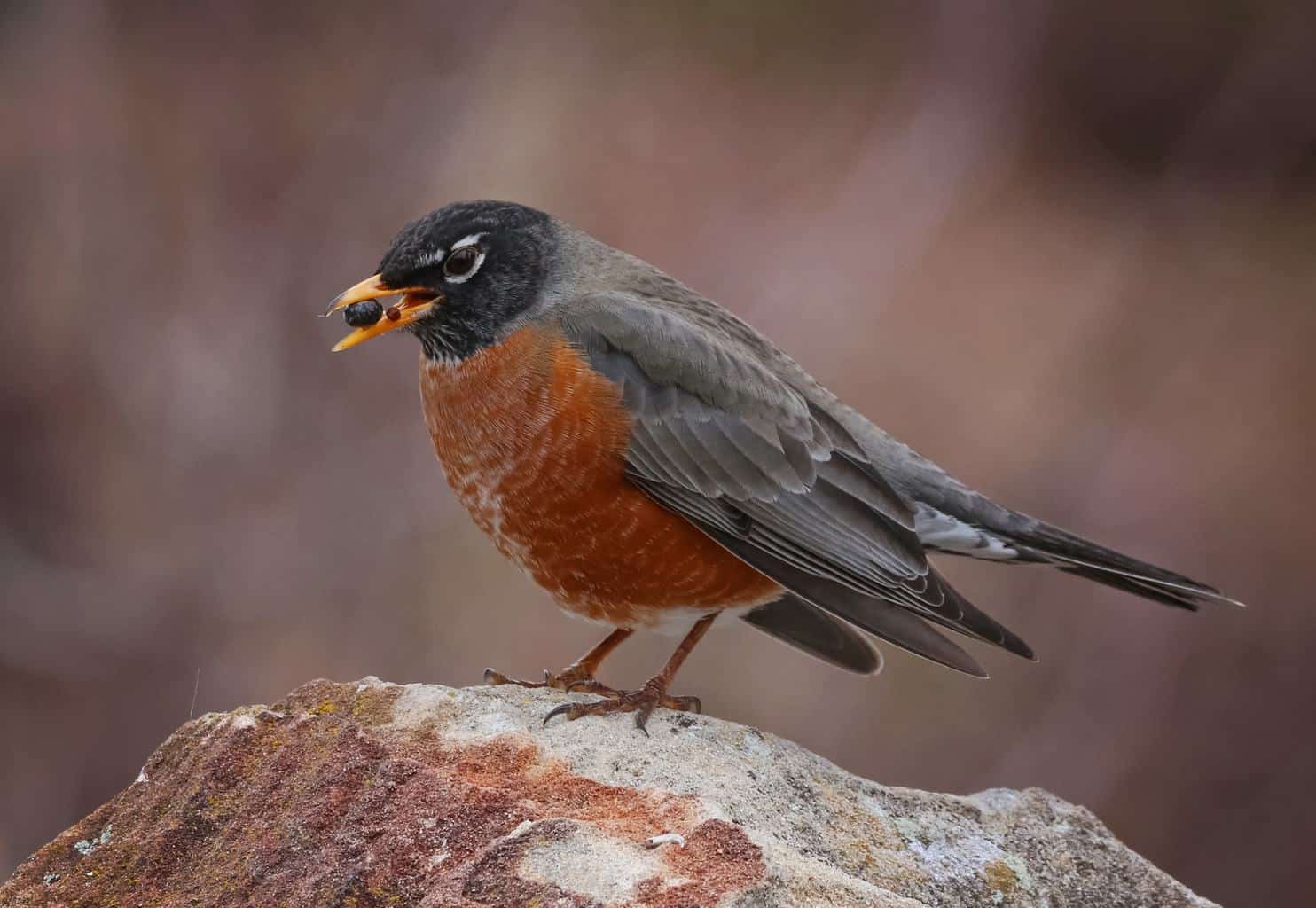
- Scientific Name: Turdus migratorius
- Length: 8 – 11 in
- Weight: 2 – 3 oz
- Wingspan: 12 – 16.5 in
American Robins are year-round residents of Illinois. They prefer open habitats, such as woodlands and farmlands. However, you can frequently spot them in urban parks. The American Robin has been recorded as one of the most commonly observed in Illinois.
American Robins have a plump body and grayish-brown wings, heads, and backs. Their chests are typically brick-red or deep orange. They have white throats with thin black stripes. You can differentiate between females and males because a male’s throat is somewhat darker than the female’s.
The males have more colorful plumage than the females. During mating season, male American Robins begin to grow black tufts of feathers on their heads to attract females.
House Finch

- Scientific Name: Haemorhous mexicanus
- Length: 5 – 6 in
- Weight: 0.5 – 1 oz
- Wingspan: 8 – 10 in
House finches are also year-round Illinois residents. They inhabit out-of-the-way suburban areas, deserts, and orchards.
This monogamous species lives in pairs. During the breeding season, the female builds the nest while the male gathers the food. Their diet includes all plant parts, including buds, seeds, and fruits. One of their most interesting features is that they can hover in mid-air to eat and drink.
Adult male house finches have bright red plumage around their faces and upper breasts. Their backs and bellies have dark brown streaks. The females, on the other hand, don’t have any red. Instead, they’re covered in greyish-brown feathers.
Northern Cardinal
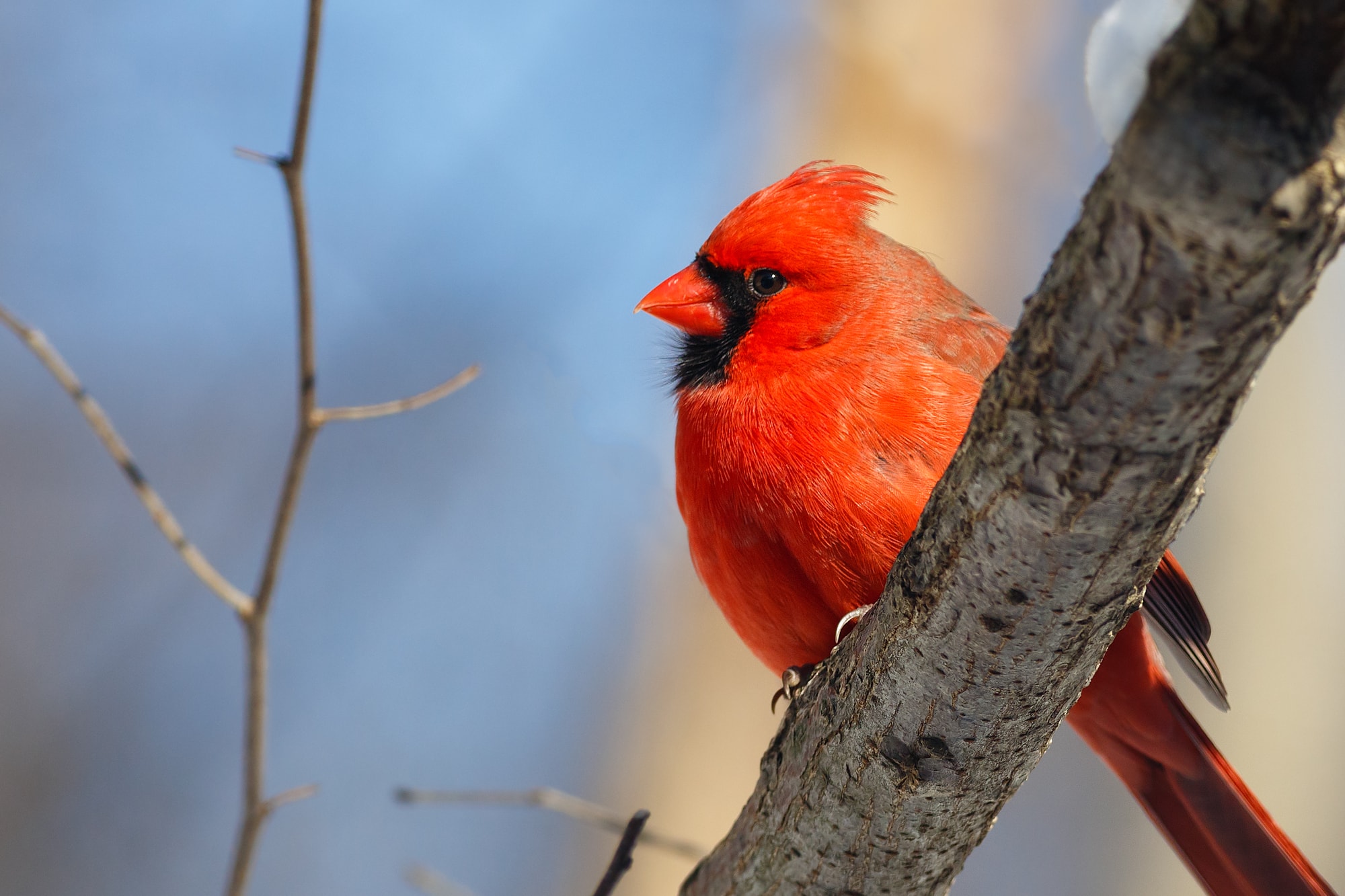
- Scientific Name: Cardinalis cardinalis
- Length: 8 – 9.5 in
- Weight: 1.5 – 2 oz
- Wingspan: 10 – 12 in
The Northern Cardinal is the Illinois State Bird. It prefers secluded habitats, such as lowlands, swamps, and thick vegetation along woodland edges. They’re also one of the most popular backyard birds.
These native birds breed from March to September. Females typically lay clutches of one to five eggs. Their diet consists of seeds, grains, and small insects. They forage for their food on the ground by hopping from one area to the next.
This beautiful bird is known for its bright red plumage, especially the male. They also have black streaks around the bill. The females are paler in comparison even though they have similar black faces as the males. Yet, in contrast with the males’ bright red feathers, females have warmer shades of red on their wings, tail, and crest.
Red Crossbill
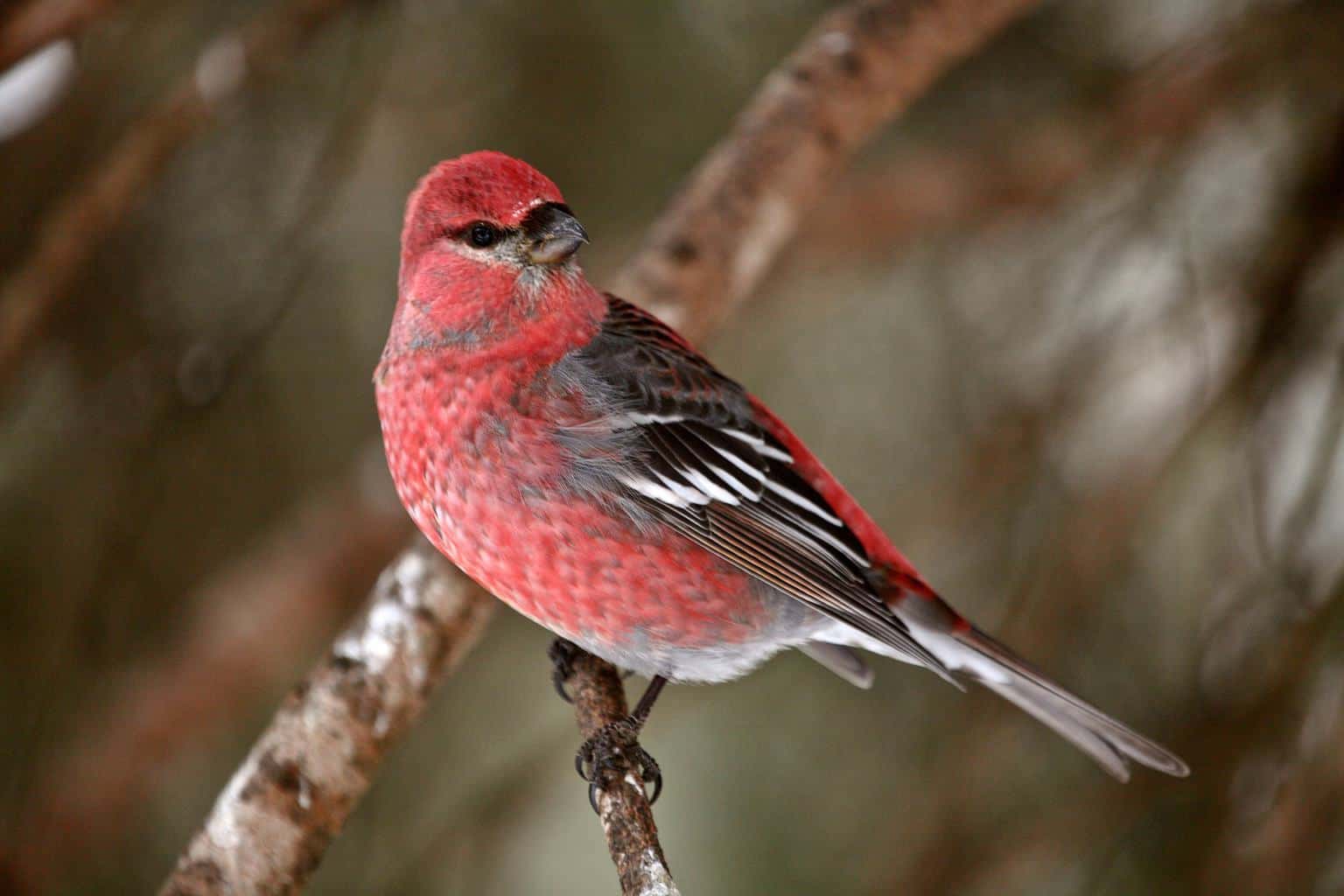
- Scientific Name: Loxia curvirostra
- Length: 5.5 – 6.5 in
- Weight: 1 – 1.5 oz
- Wingspan: 10 – 11 in
Red crossbills are dependent on confider seeds and spruce cones for food and shelter.
They breed any time during the year providing the conditions are right, and there’s ample cone crop. This makes them a nomadic species rather than regular migratory birds. To prepare for breeding season, they build their nests on conifer branches. The female builds it using mostly moss, grass, and bark roots.
Red crossbill males are covered in brick red plumage. Their wings and tail are a darker shade of red that’s almost brown. Females are more diverse in their coloration. They range from yellowish-brown to olive-brown, and even greenish-brown in some cases.
Red-Headed Woodpecker
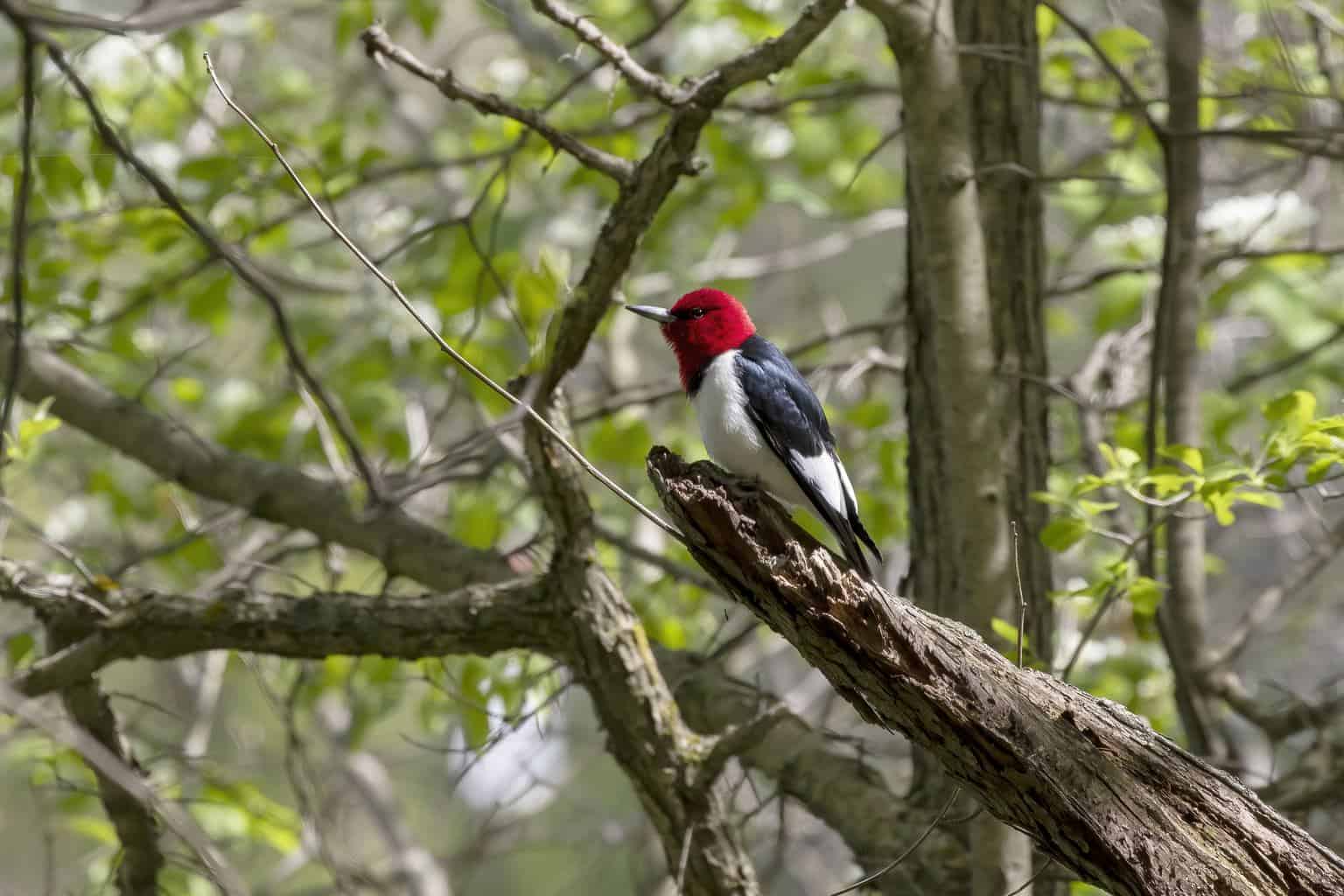
- Scientific Name: Melanerpes erythrocephalus
- Length: 7.5 – 10 in
- Weight: 2 – 3 oz
- Wingspan: 16 – 18 in
These familiar birds, and their cousins, the Downy Woodpecker, are year-round residents of Illinois. They prefer open habitats, like meadowlands and pastures. You can easily locate them because of their loud pecking noises. During the breeding season, males become even louder in hopes of attracting a female.
They’re known to forage on the ground instead of carving out holes in trees to find insects. Then, after gathering enough of their favorite foods, they store it somewhere safe and cover it with bark strips.
Both adult females and males have bright red heads, necks, and throats. Their bellies and underparts are white, and they have black backs. Yet, if you catch a glimpse of them in the sunlight, it may seem that the feathering on their backs is closer to a dark shade of blue.
Blue Birds in Illinois
Belted Kingfisher
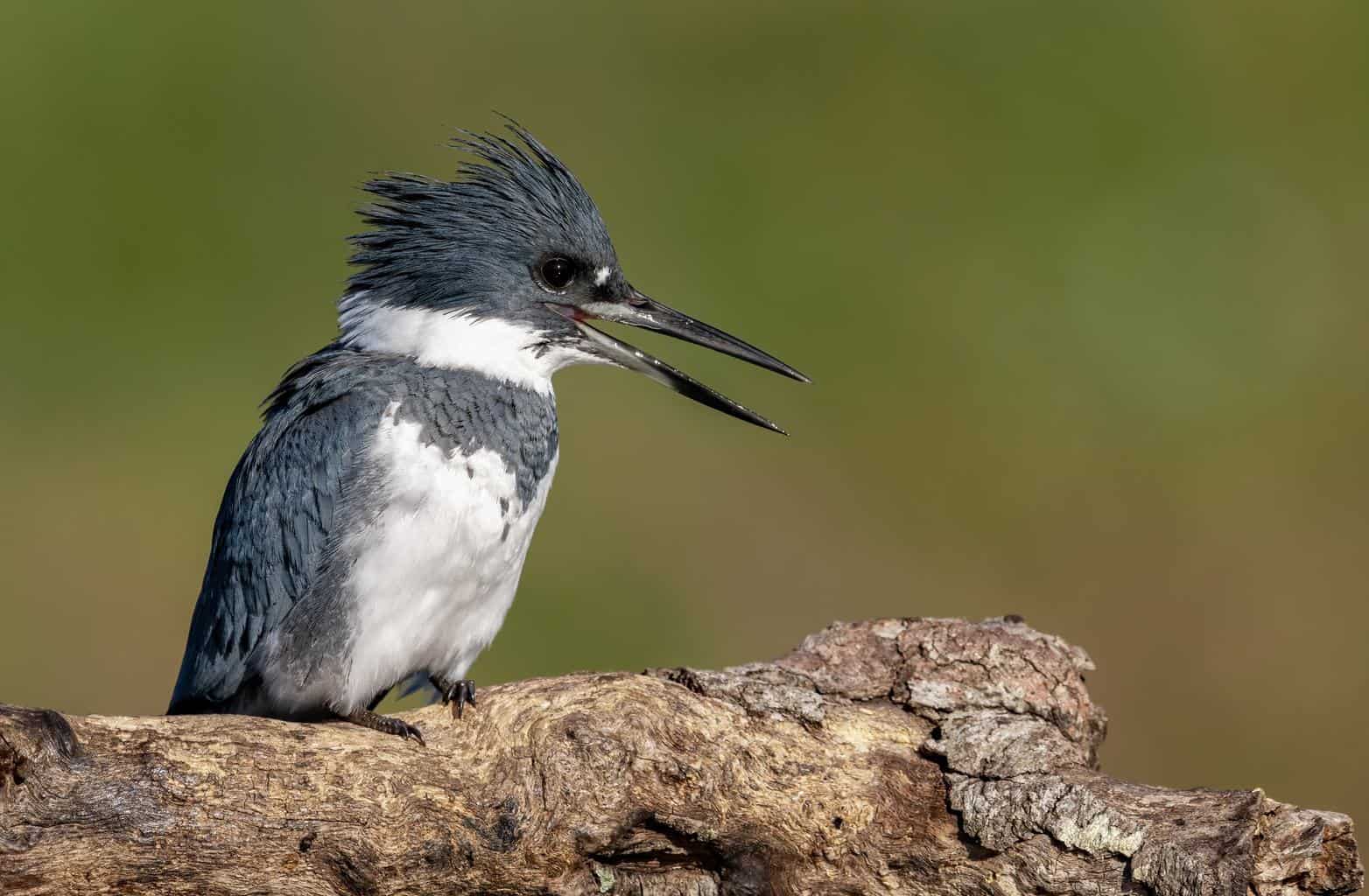
- Scientific Name: Megaceryle alcyon
- Length: 11 – 14.5 in
- Weight: 5 – 6 oz
- Wingspan: 20 – 25 in
Belted Kingfishers are known for their slow and steady flight pattern. They like to hover over water in search of prey. Unfortunately, they’re often hunted by hawks. So, to avoid being eaten, they may take a quick dive into the water.
These year-round Illinoisans dig out nest burrows about 24 to 35 inches long. Kingfisher tunnels may take several weeks to dig, and they reuse them year after year.
The Belted Kingfisher is covered in blue-gray plumage. Their tails and wings have patches of small, white dots. The males and females have white underparts. However, females have an extra broad rust-colored thick stripe on their bellies.
Blue Jay
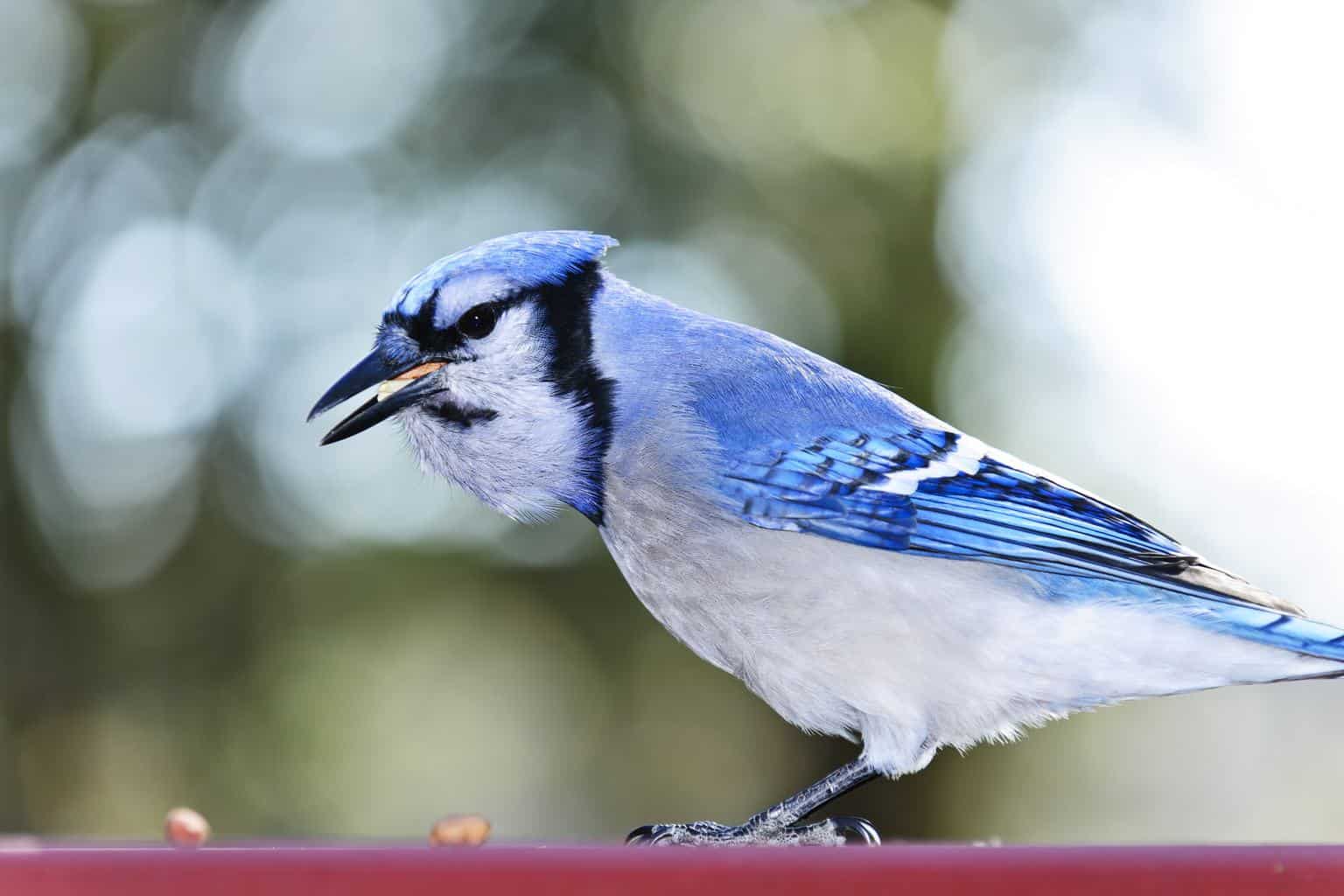
- Scientific Name: Cyanocitta cristata
- Length: 9 – 12 in
- Weight: 2.5 – 3.5 oz
- Wingspan: 13 – 17 in
Blue Jays inhabit farmlands, evergreen forests, and even suburbs. You can easily spot them gliding through the air with their steady wing beats.
Their diet includes nuts, seeds, and fruits. Sometimes, they may steal other birds’ nests and prey on their eggs.
What’s most interesting about Blue Jays is their coloration. Their blue plumage is a result of how their feathers refract light rather than any pigmentation. The plumage on their backs and wings is brown, black, or white. It can also appear as various shades of blue when light shines on their backs. The underparts of the Blue Jay are typically light gray or a basic shade of white.
Eastern Bluebird
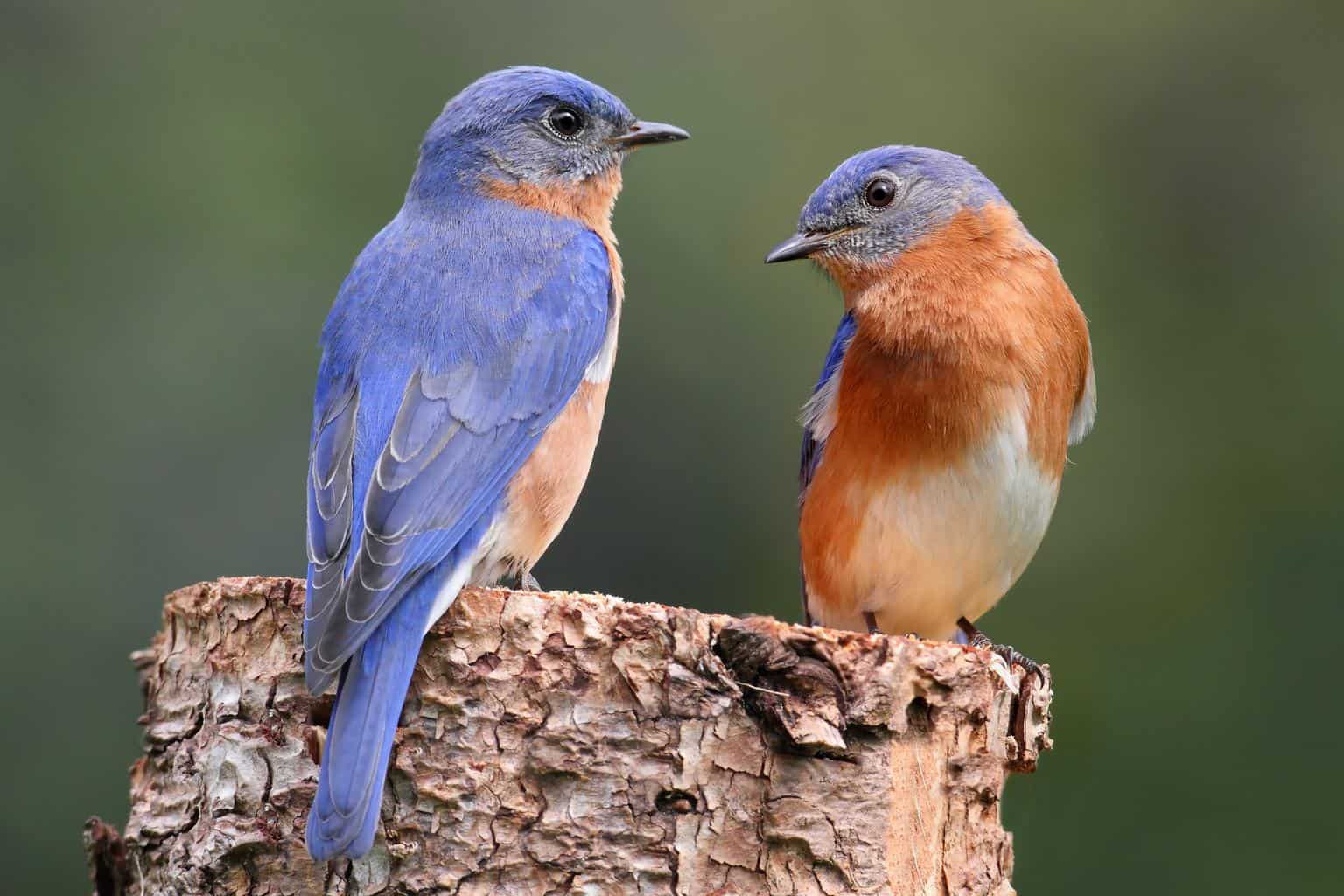
- Scientific Name: Sialia sialis
- Length: 7 – 8 in
- Weight: 1 – 1.5 oz
- Wingspan: 11.5 – 13 in
The Eastern Bluebird enjoys foraging in open areas. It usually feeds on insects, spiders, and earthworms.
They can be spotted year-round in Illinois during the summertime. In the winter, they head to the southern parts of the state, where they feed on berries and seeds. Unfortunately, their numbers are declining because house sparrows and starlings threaten them. These aggressive species kick Bluebirds out of their nests, then claim it as their own.
Males appear to be covered in rich blue plumage in the light, with a necklace of black and a blue crest. Yet, they look plain brown or gray from a distance. Females have bluish tinges on their wings and tails. Their backs are grayish-brown, and their breasts and bellies are a pale shade of orange.
Indigo Bunting
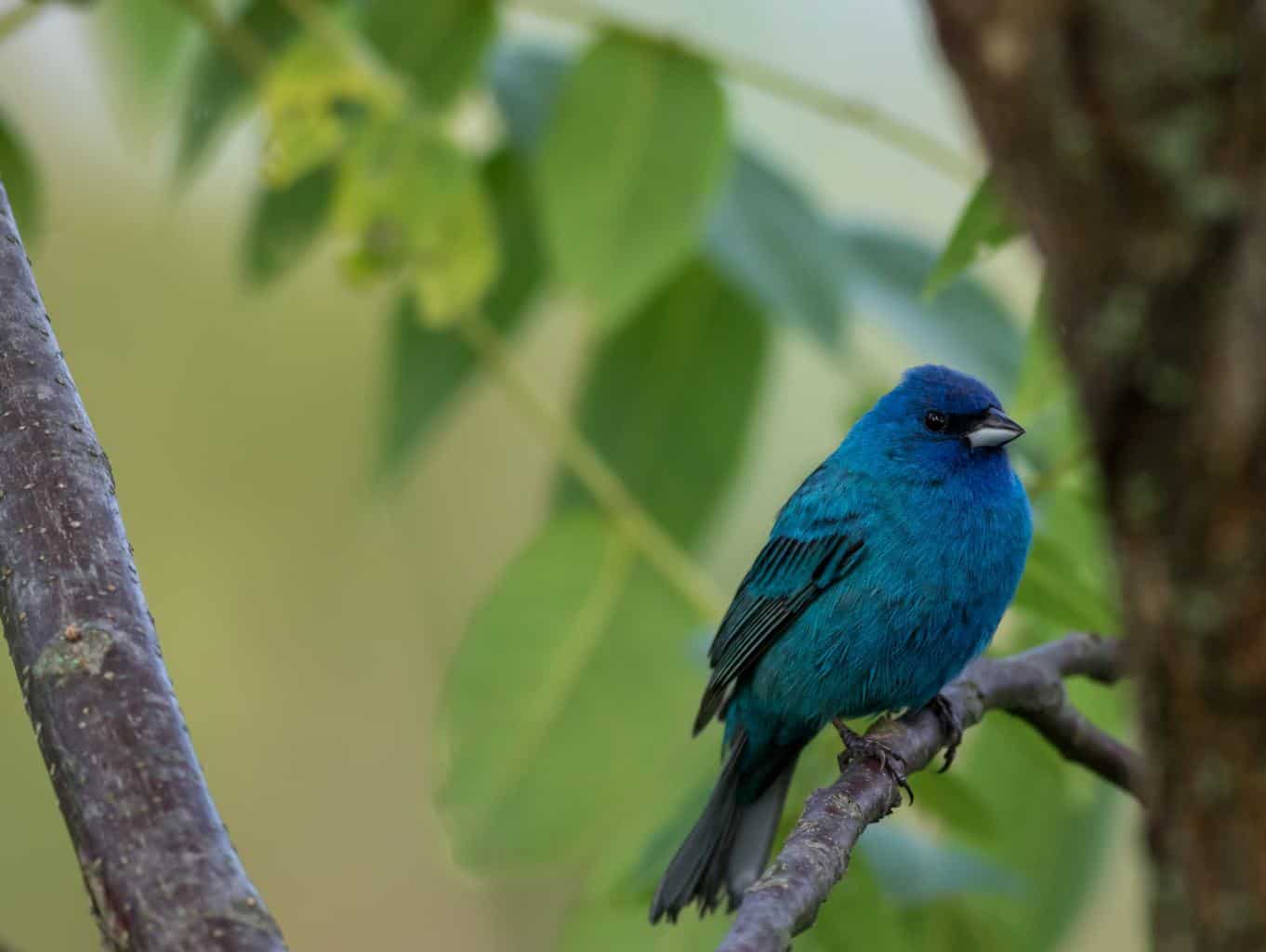
- Scientific Name: Passerina cyanea
- Length: 4.5 – 6 in
- Weight: 0.5 – 1 oz
- Wingspan: 7 – 9 in
Indigo Buntings are summer residents of Illinois. During migration, they follow the pattern of stars closest to the North Star to guide them. They inhabit forest edges, woodland clearings, and old pastures. It’s where they most easily find food, which includes berries, insects, and buds.
These small birds are actually black. They appear blue because of the diffraction of light through their plumage. However, this is true only for the males, which have indigo-colored feathers on their heads. Their faces, wings, and tails are black, with deep blue streaks on the edges. In contrast, females a traditional shade of brown and aren’t nearly as colorful.
Purple Martin
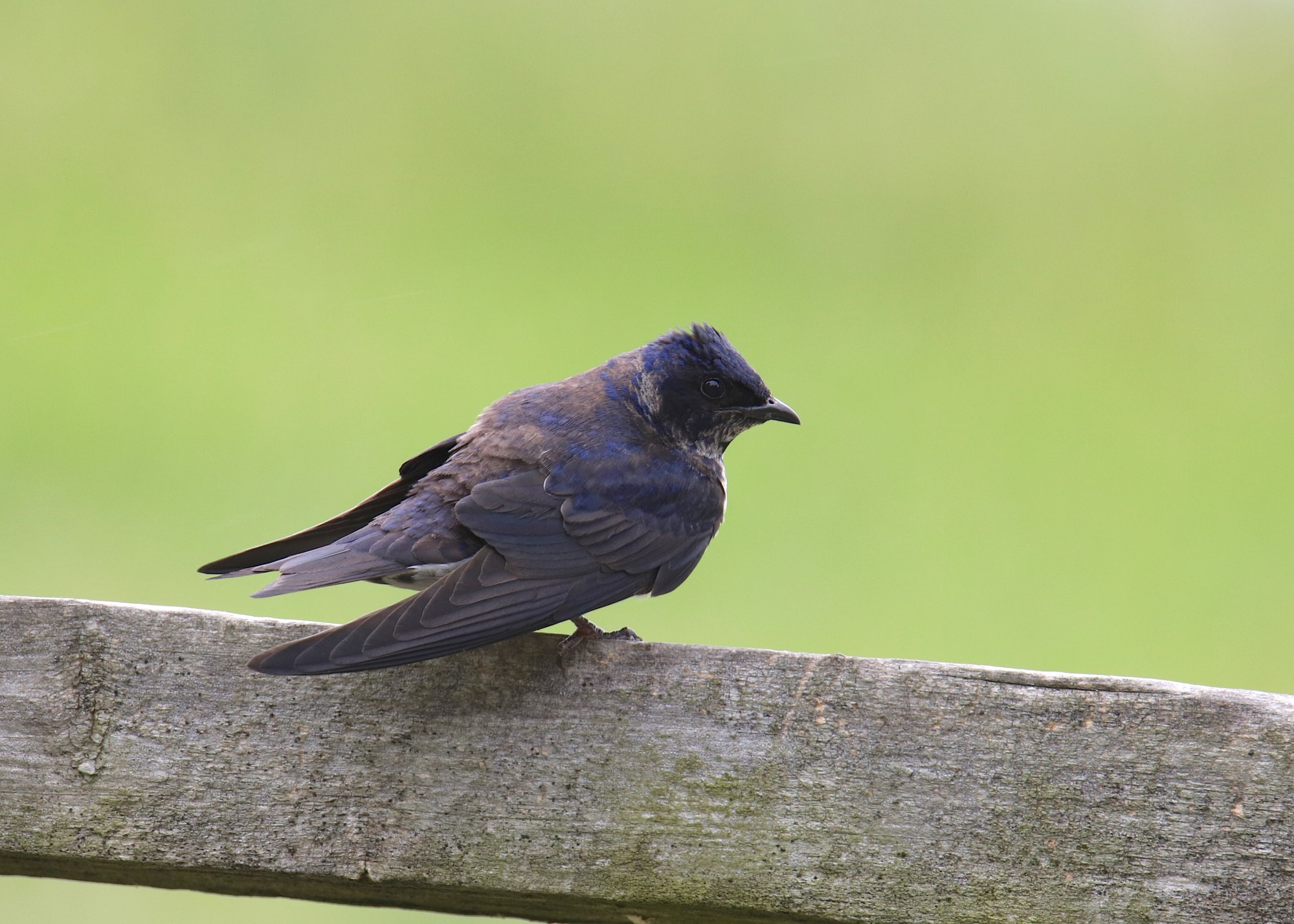
- Scientific Name: Progne subis
- Length: 7.5 – 8.5 in
- Weight: 2 – 2.5 oz
- Wingspan: 15.5 – 17 in
Because of their quick flying speeds, Purple Martins can snack on their favorite prey: insects. In fact, Purple Martins are experts at catching different types of insects mid-flight. They enjoy the warm summer months in Illinois, usually in agricultural lands or open woodlands. They’re known for their graceful, strong flight and long glides.
Purple Martin males are actually more blue than purple. It’s their iridescent feathering that makes them appear to be purple all over. Females aren’t as colorful. They have gray on their heads and breasts with white feathering on their lower bellies. The tails and wings on both the males and females are streaked with brown and black markings.
Green Birds in Illinois
Acadian Flycatcher
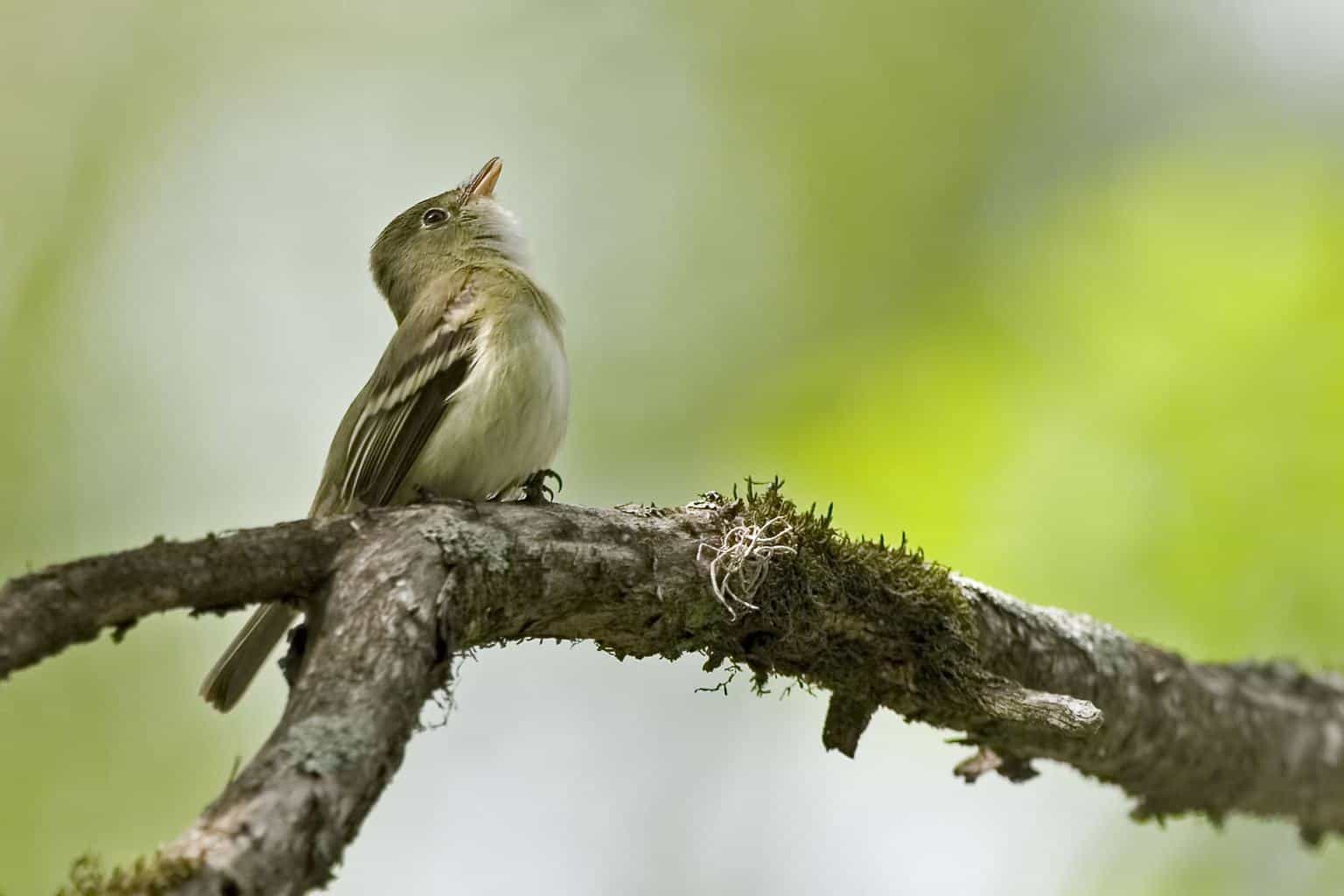
- Scientific Name: Empidonax virescens
- Length: 5 – 6 in
- Weight: 0.5 – 1 oz
- Wingspan: 8 – 9 in
Acadian Flycatchers stay in Illinois during the summer. They set up their nesting grounds in deciduous forests, hidden away under canopies. These small and adorable birds are expert fliers with shallow wing beats. Besides hovering and gliding with ease, they can also fly backward.
The diet of an Acadian Flycatcher consists of a variety of flying insects. They perch on low branches and wait until their food is close by to snatch up in mid-air.
The Acadian Flycatcher has olive green coloring on its upper part. The bill is dark brown, while below, it’s yellowish-orange. The underparts are mostly white. This is in stark contrast with their dark wings that have two distinct white wing bars on them.
Black-Throated Green Warbler
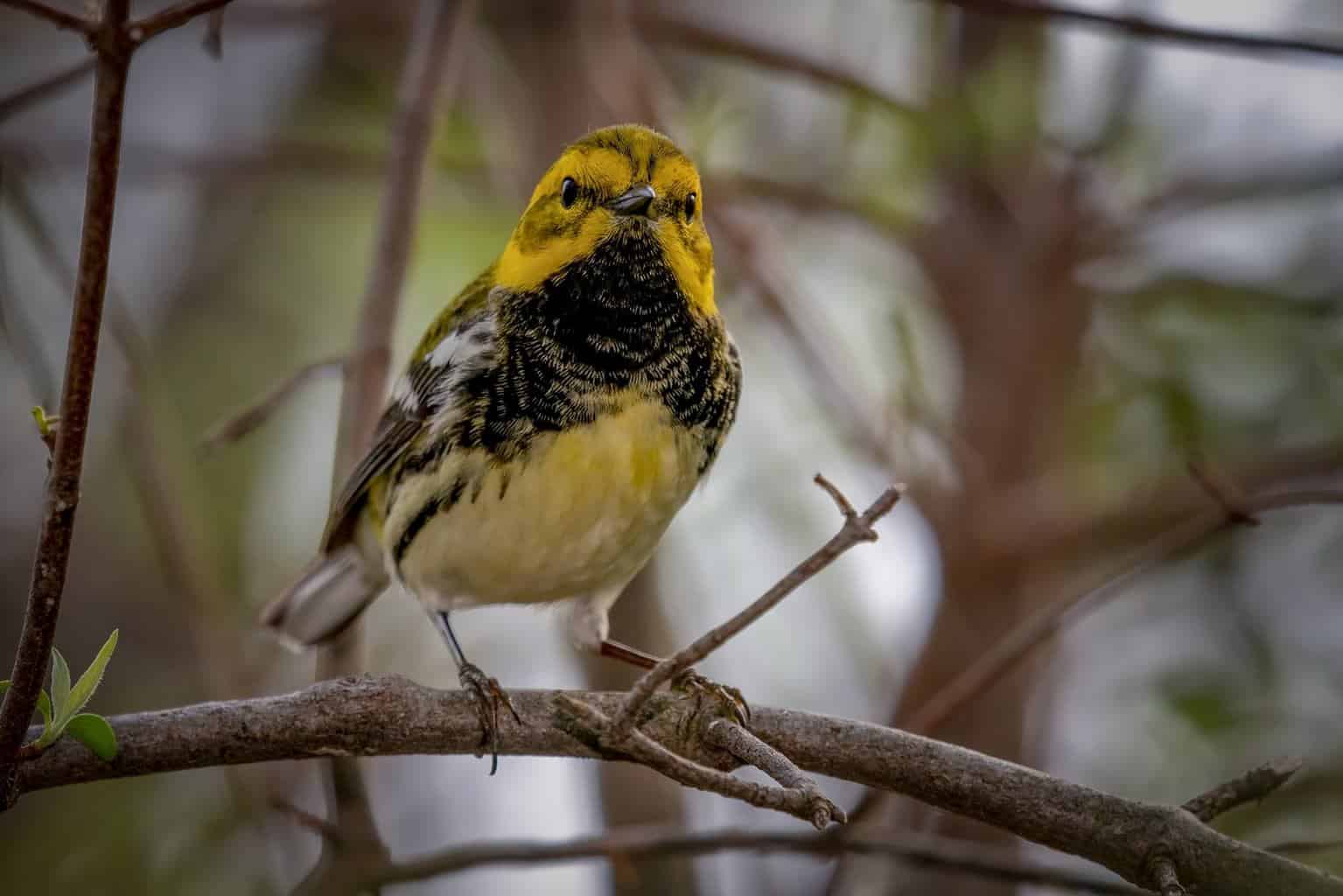
- Scientific Name: Setophaga virens
- Length: 4.5 – 5.5 in
- Weight: 0.3 – 0.5 oz
- Wingspan: 7 – 8 in
Balck-throated Green Warblers are migratory birds that rest in Illinois during their seasonal flights. They breed in the far north during the summertime and spend their winters in the tropics. Their preferred habitat is open strands of pine or hemlock trees. It’s where they can easily find insects, nuts, and seeds.
Black-throated Green Warblers are distinguished by their olive-green upperparts and crowns and, obviously, their black throats. Males have bright yellow faces, necks, and backs. Their dark green bellies and wings have white bars that reach their flanks and give them their unique appearance. Females are a warmer shade of yellow with a yellow-green. In addition, they have white underparts with broad dark streaks.
Monk Parakeet
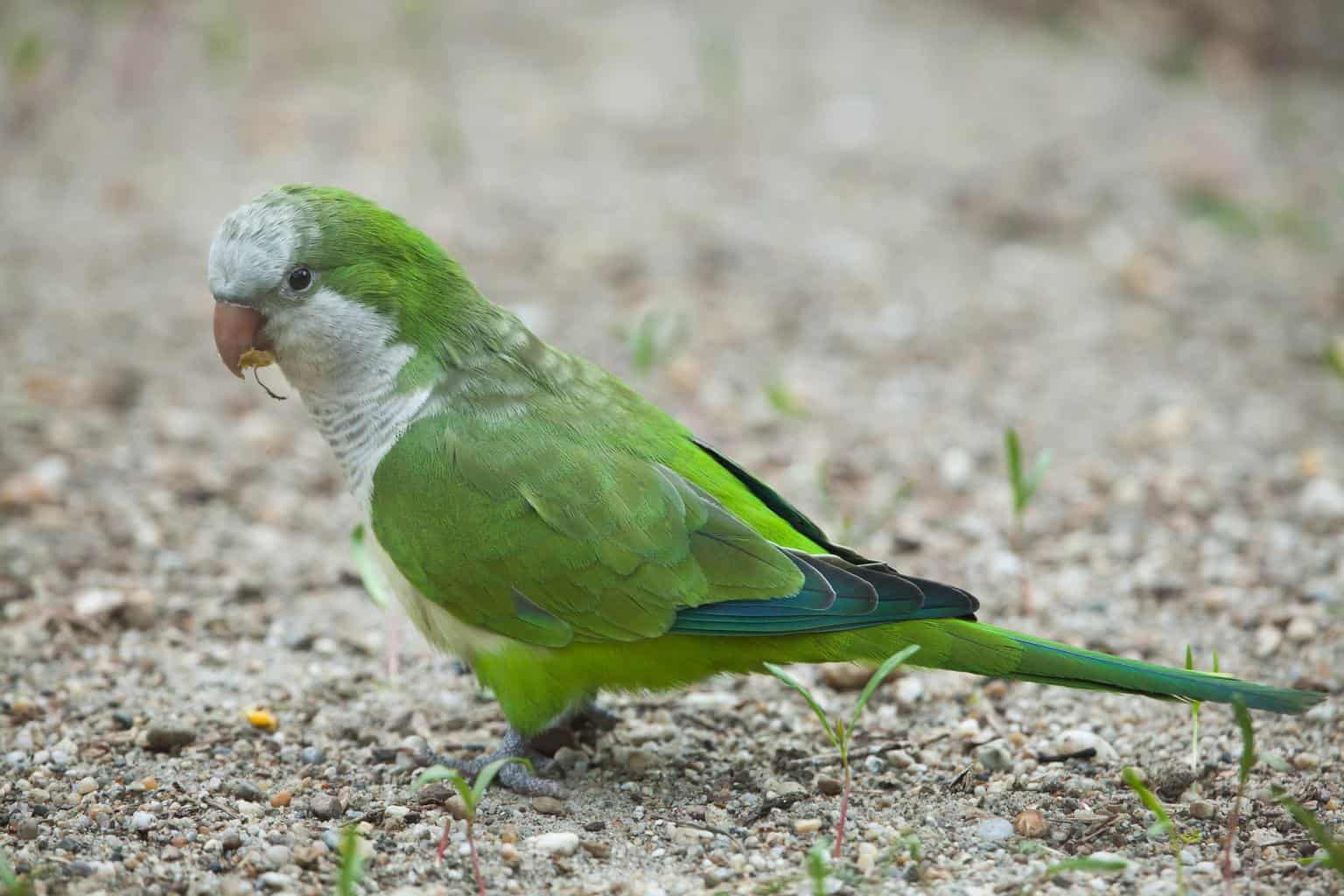
- Scientific Name: Myiopsitta monachus
- Length: 11 – 12 in
- Weight: 3 – 4 oz
- Wingspan: 17 – 19 in
If you think parakeets live only in the tropics, think again! The Monk Parakeet is a year-round resident of a small portion of Illinois. These graceful birds prefer urban and suburban habitats. We’ve also seen them flying around in city parks and urban areas in search of tasty snacks.
Monk Parakeets are the only species of parakeets to nest in a colony, often on tall structures. These communal nests help them survive the harsh winters of northern Illinois.
Monk parakeets have a pale pink bill. Their heads, backs, and wings are a vibrant green. Their underparts are light gray or white. When they’re flying, their wings open up to reveal various shades of blue.
Pine Warbler
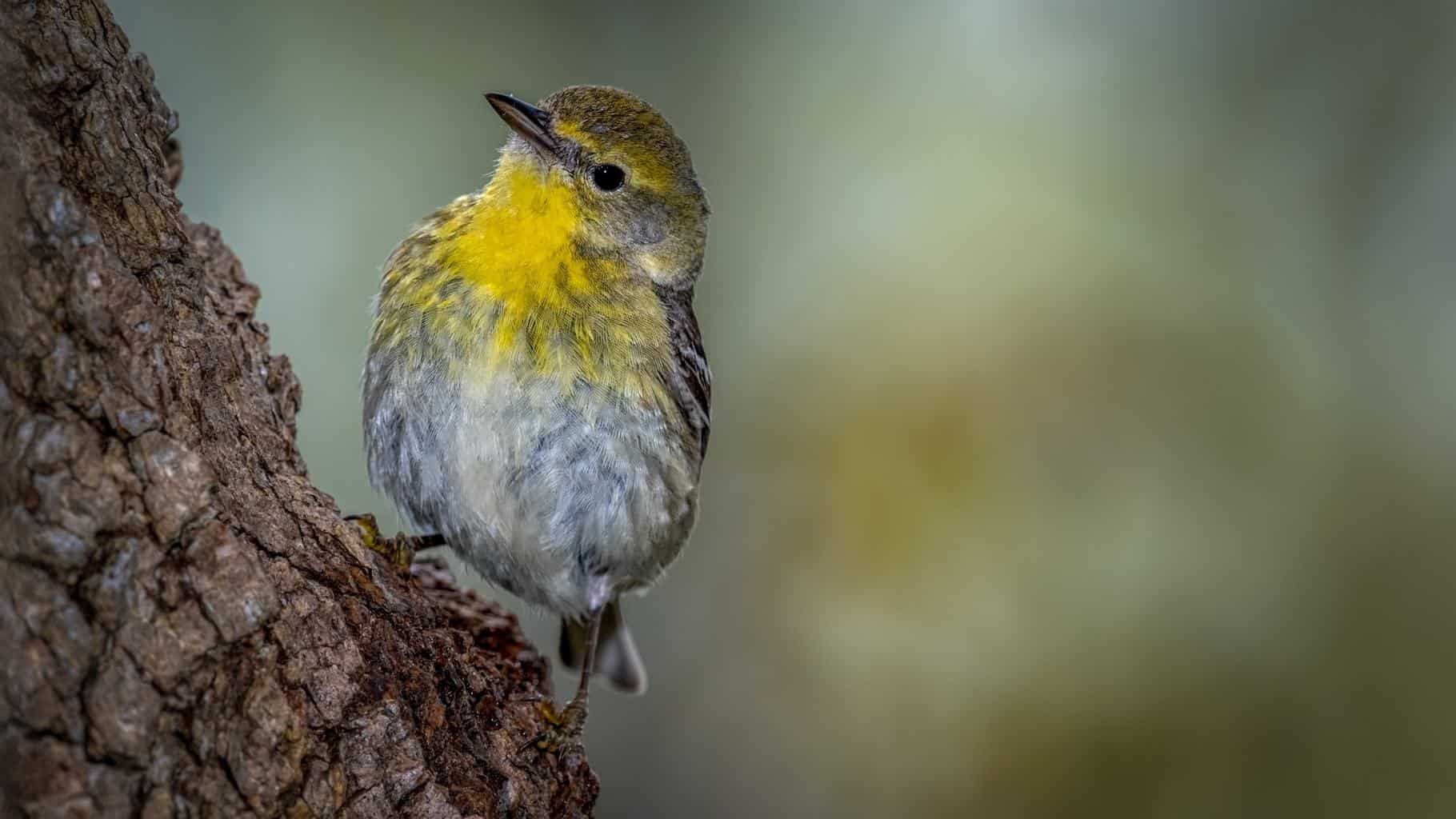
- Scientific Name: Setophaga pinus
- Length: 5 – 5.5 in
- Weight: 0.5 – 1 oz
- Wingspan: 8.5 – 9 in
Pine Warblers prefer coniferous forests where they can hide in between the cones and needles. You can spot them year-round in the southern regions of Illinois. They’re found in other parts of the state only during their migration, which occurs in early spring and late fall.
These are one of the earliest breeders of all the warbler species. Males begin their mating songs as early as February, whereas others begin in late April.
Pine warblers are mainly covered in subdued colors to blend in with their environment. The males are somewhat brighter than the females. Both have olive-green or grayish-brown backs and white bellies. One of their most noticeable features is the two broad white bars on their dark gray wings.
Ruby-Throated Hummingbird
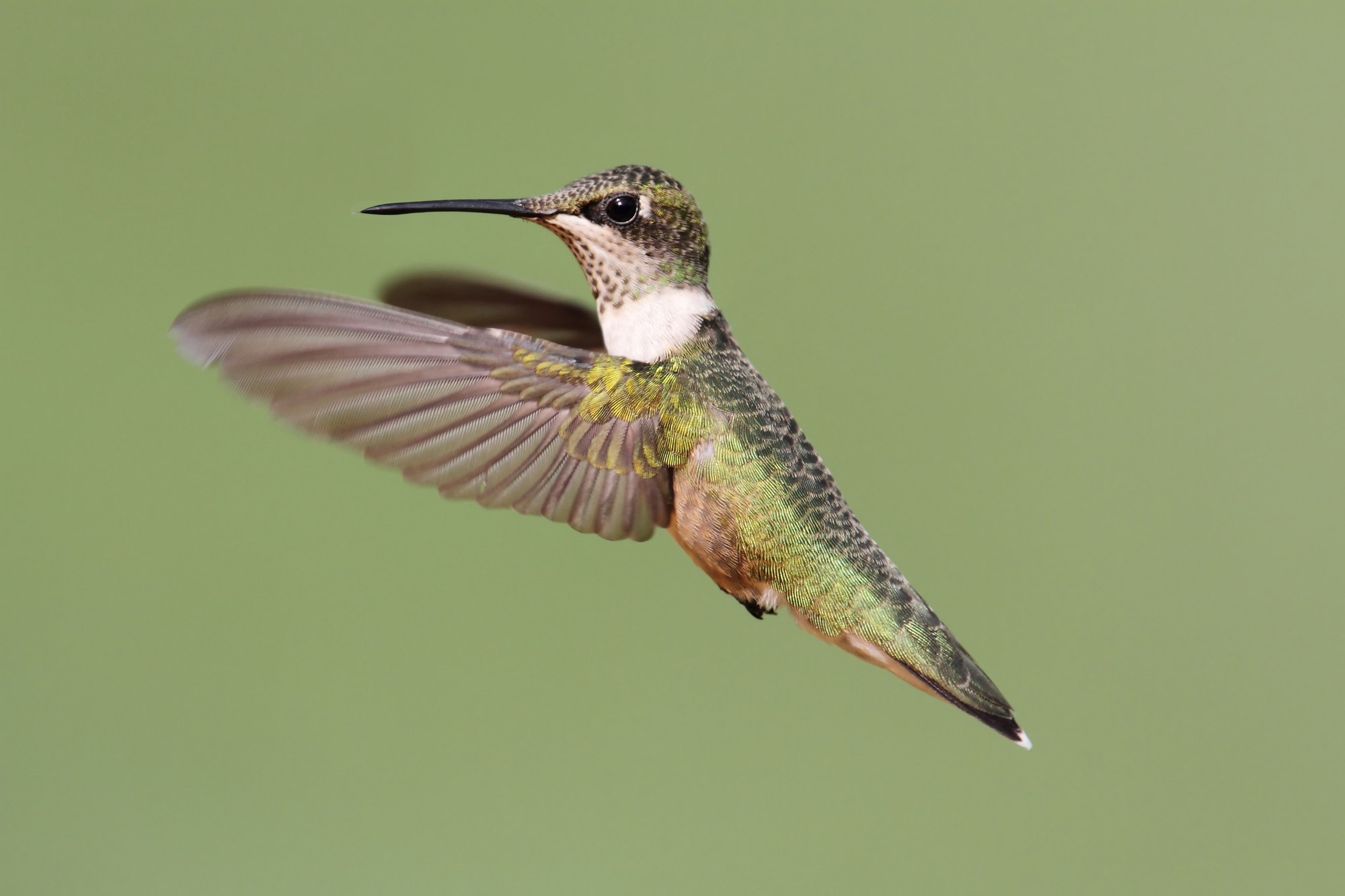
- Scientific Name: Archilochus colubris
- Length: 3 – 4 in
- Weight: 0.1 – 0.5 oz
- Wingspan: 4 – 5 in
One of our favorite birds is the Ruby=throated Hummingbird. This medium-sized hummingbird is a summer resident of this northern state. You can find them in places where there’s plenty of nectar. Their favorite flowers are lilacs, petunias, and honeysuckle. Hummingbird feeders work very well in attracting them. They also prey on spiders and insects as well.
We all know that hummingbirds are amazing fliers. Using their rapid wing beats, they hover in place and move forward and backward with the help of their powerful wings.
Ruby-throated Hummingbirds have either bright golden-green or emerald on their backs and crowns. Their bellies are grayish-white. Males have a shiny, iridescent red throat and neck. When the lighting isn’t ideal, they appear to be almost black.
Orange Birds in Illinois
American Redstart
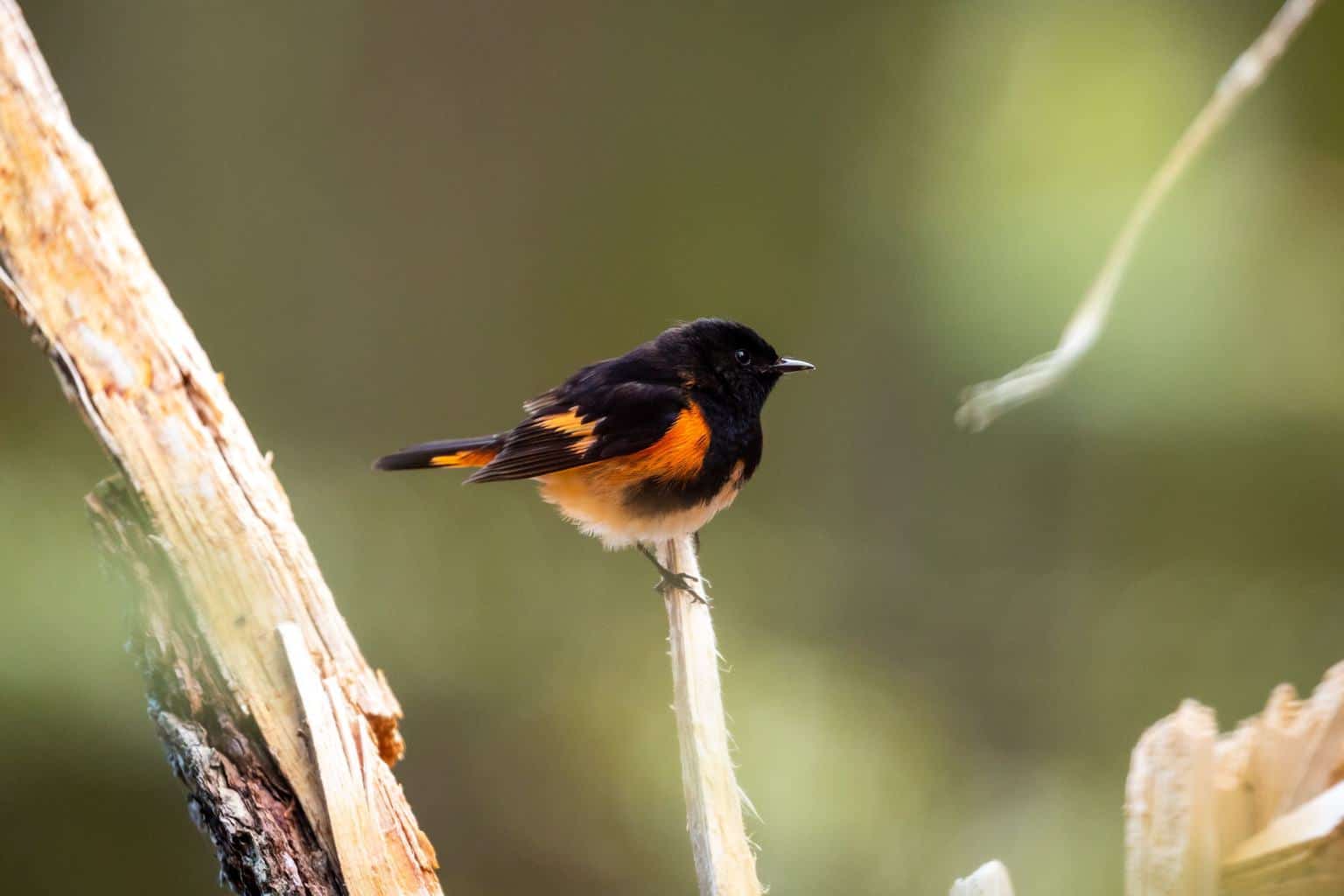
- Scientific Name: Setophaga ruticilla
- Length: 4 – 5.5 in
- Weight: 0.3 – 0.5 oz
- Wingspan: 6 – 9 in
During the summer, American Redstarts usually inhabit second-growth woodlands foraging for food. Their diet consists of spiders, insects, and seeds.
Adult males are mainly black all over with white bellies. However, those colorful patches of bright orange on their wings and flanks give them their unique look. Females have yellow or yellow-orange patches in place of the orange on the males. Their heads and underparts are mostly gray. Yet, it’s their tails that are their most appealing quality. Bright orange-red, their tails often quiver to frighten prey into coming out of hiding.
Their bright plumage gives them the nickname ‘butterflies of the bird world.’ They also have a quick bobbing motion that resembles that of a butterfly.
Baltimore Oriole
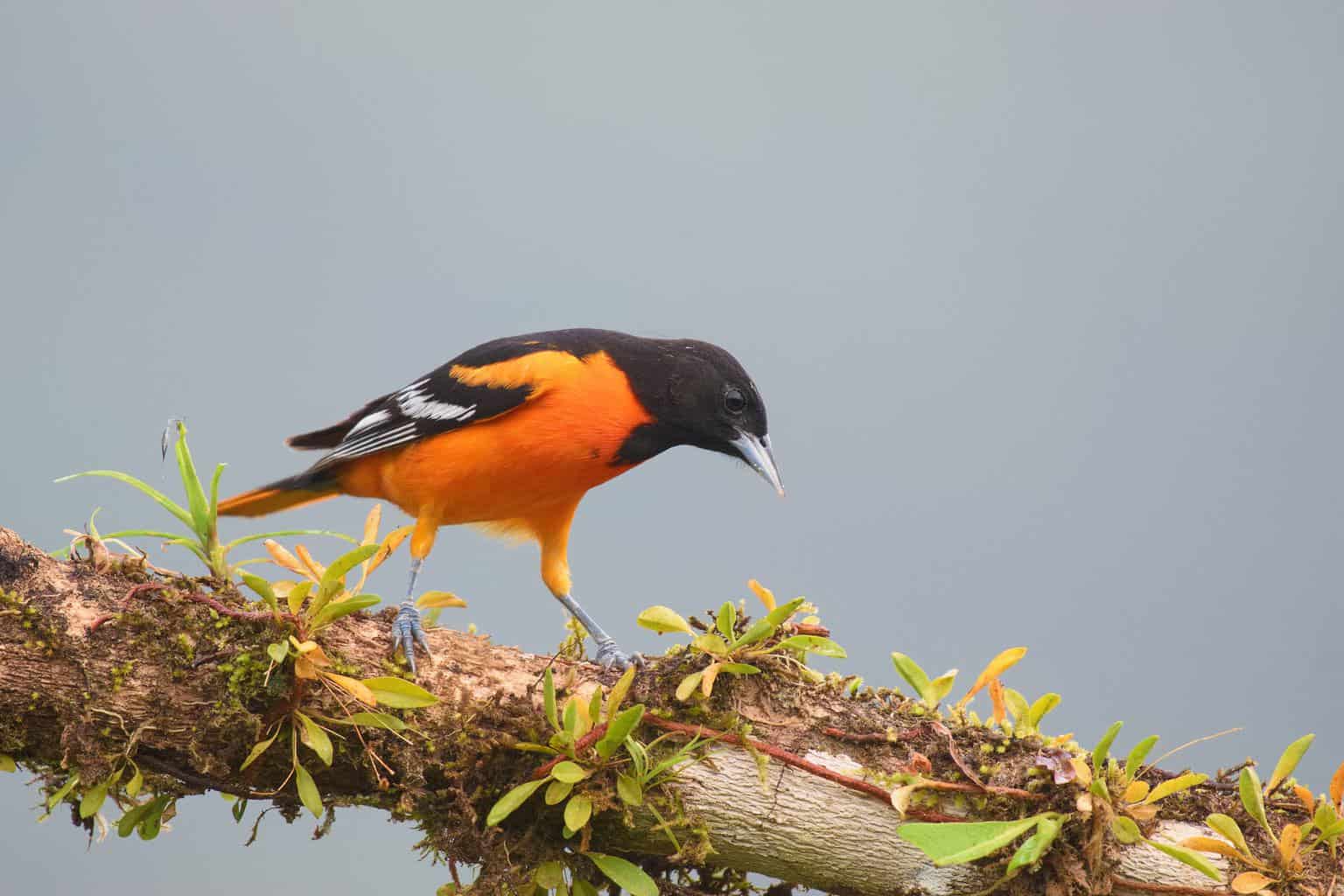
- Scientific Name: Icterus galbula
- Length: 7 – 8 in
- Weight: 1 – 1.5 oz
- Wingspan: 11 – 12.5 in
Baltimore Orioles (the birds, not the baseball team) like feeding on flower nectar, fruits, and garden peas. They’re usually found near shade trees and open woodlands. They also prey on insects, caterpillars, and aphids. They pluck them off leaves and twigs through a process called gleaning.
You can find these birds in Illinois during the hot summer months. Just look for a small-sized bird species with orange and black plumage. Adult males have a solid-black head. Their wings are also black with one single white bar. Females are gray on their heads and backs. Their breasts are yellow-orange, and their dark wings have two white bars instead of one.
Barn Swallow

- Scientific Name: Hirundo rustica
- Length: 5.5 – 7.5 in
- Weight: 0.5 – 1 oz
- Wingspan: 12.5 – 13.5 in
Barn Swallows are the most widely distributed swallows in the world. Yet, they prefer marshes, lakeshores, and agricultural lands. One of their most prominent qualities is that both the males and females build the nest. They also take turns searching for food.
These opportunistic hunters take advantage of mowing or plowing. It’s when they most easily find insects, such as grasshoppers, dragonflies, and beetles.
Barn swallows have a steely shade of blue on their tails, wings, and backs. Their underparts are reddish-orange. Their crowns and faces are a light tinge of blue. It makes a nice contrast with their cinnamon-colored foreheads.
Blackburnian Warbler
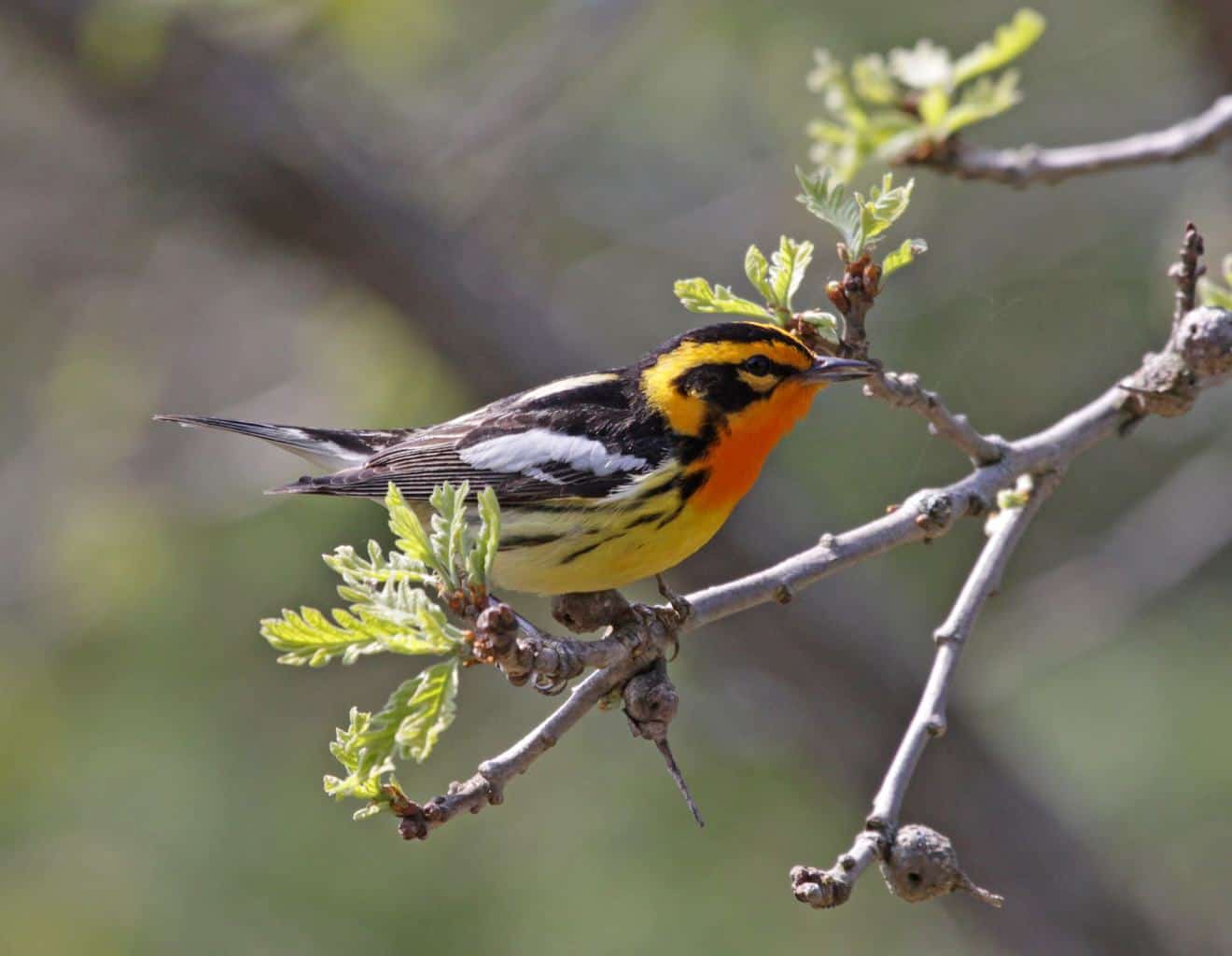
- Scientific Name: Setophaga fusca
- Length: 4.5 – 5 in
- Weight: 0.3 – 0.5 oz
- Wingspan: 8 – 9 in
Blackburnian Warblers are small birds typically found in hemlock, pine, and spruce forests. They usually hop from branch to branch foraging for food. They’re also experts at grabbing insects in mid-air.
Their diet consists of coniferous trees, consuming both the upper and outer parts. Blackburnian warblers like feeding on caterpillars and beetles as well.
The Blackburnian Warbler is the only North American warbler with an orange throat and chest. It makes it quite easy to tell it apart from other warblers. Both males and females have dark top parts and wings with white bands. Their bellies are light gray with thin dark gray streaks.
Cliff Swallow
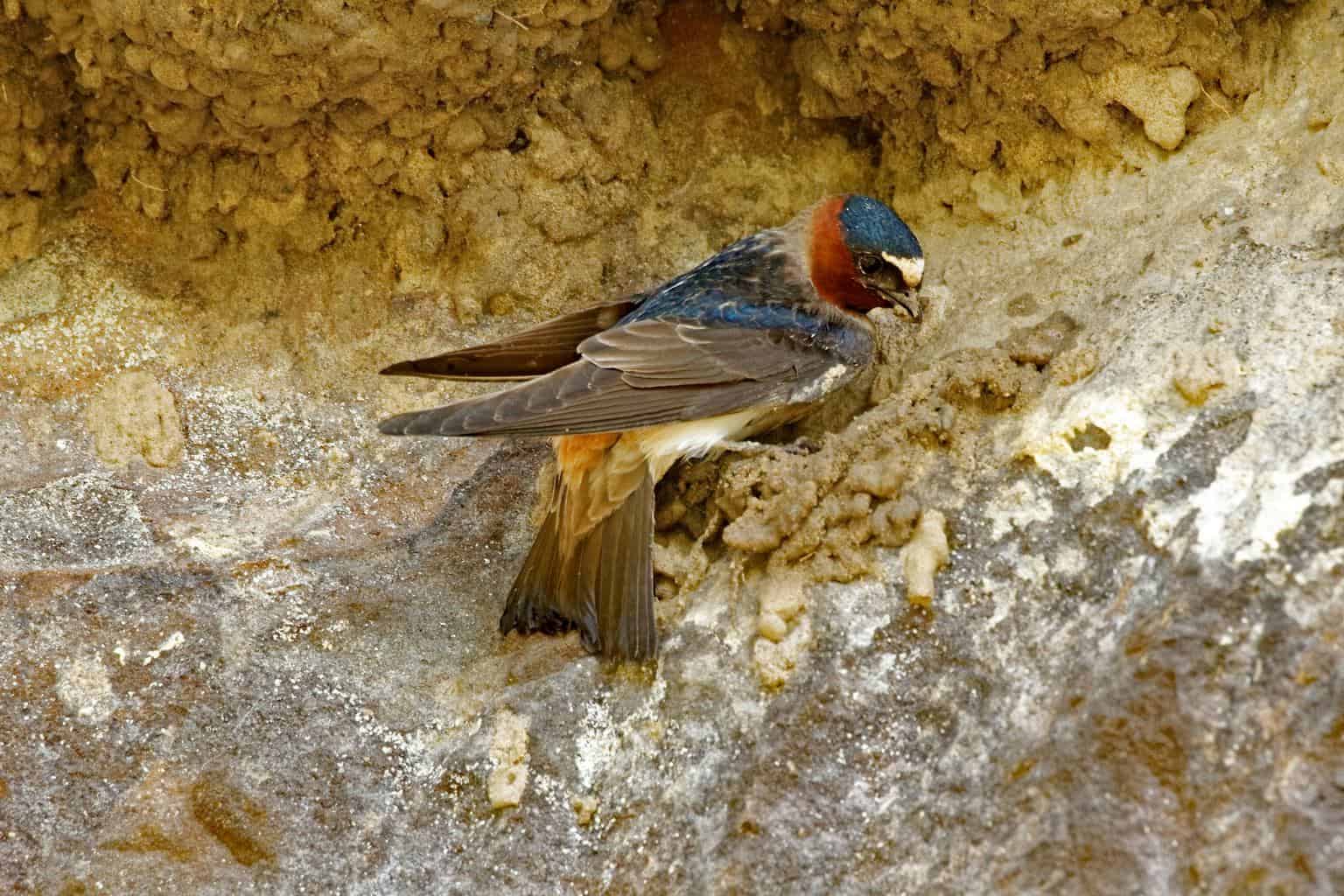
- Scientific Name: Petrochelidon pyrrhonota
- Length: 5.5 – 6 in
- Weight: 1 – 1.5 oz
- Wingspan: 11 – 13 in
You can spot the migratory Cliff Swallow in marshes and on the lakeshore. Still, they prefer open areas near cliffs and farmlands.
These summer residents eat mostly insects. They also feed on berries and nuts.
Cliff Swallows have distinctive plumage in various shades of orange. Their underparts are a pale gray. When the light is ideal, you can see their metallic blue backs and pale orange-colored tails. Their faces are brick-red and distinguished with a buff-white patch of feathering on their forehead. Yet, their square tails are their most notable feature, allowing for faster, more graceful flights.
Yellow Birds in Illinois
American Goldfinch
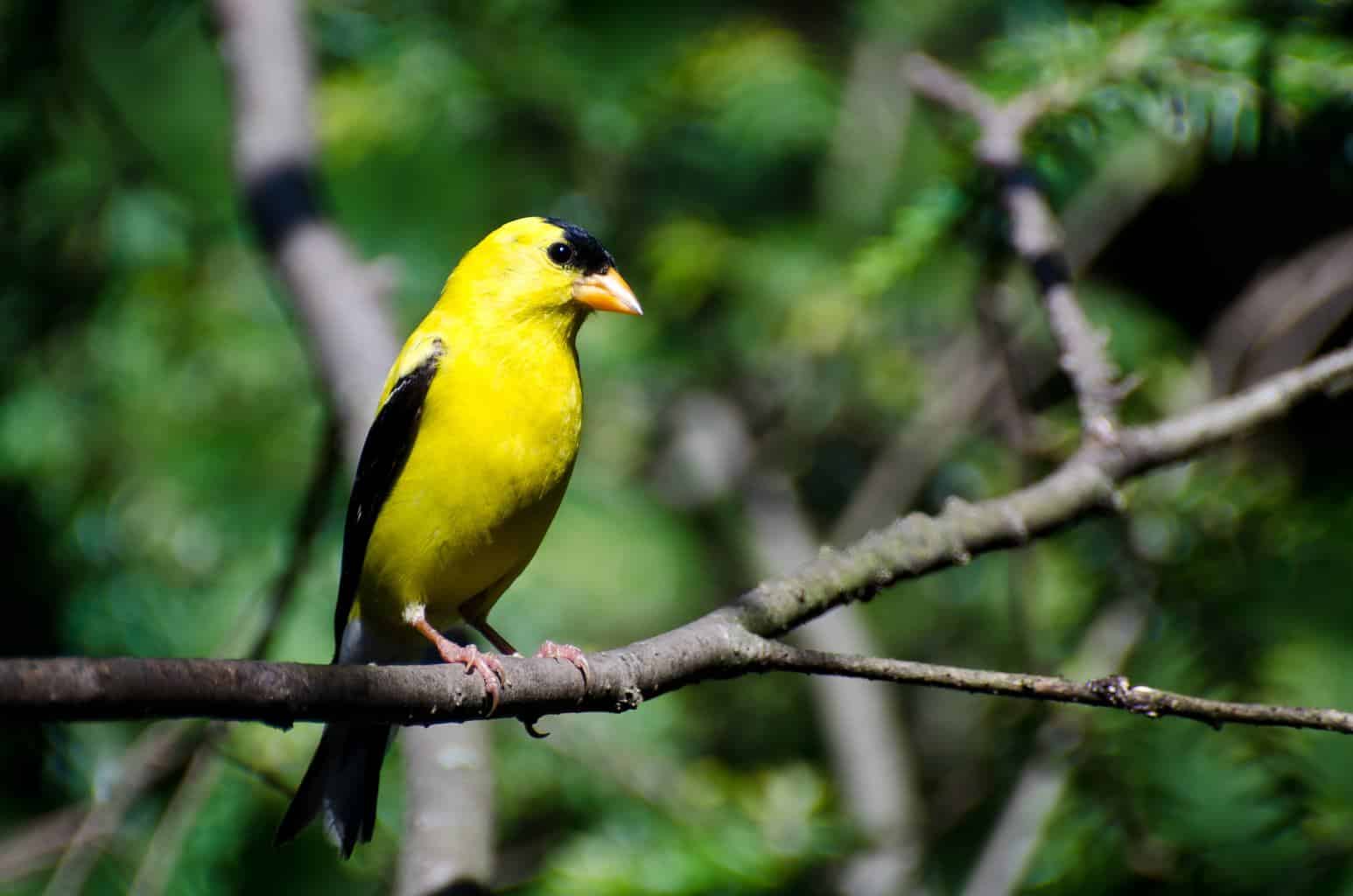
- Scientific Name: Spinus tristis
- Length: 4 – 5.5 in
- Weight: 0.4 – 1 oz
- Wingspan: 7.5 – 9 in
American Goldfinches are a chatty little bunch. These year-round residents feed on seeds directly off the tree rather than foraging for them on the ground. Their preferred habitat is grasslands and thickets. They nest late in the year, during the summer months. This late timing could be because of a lack of suitable nesting materials or appropriate food for the young chicks.
Adult males are bright yellow with a black cap. Their black wings and dark tail have white markings. Females are a dull shade of yellow. Their underparts are more olive-yellow with blackish-brown wings that have two pale bars.
Common Yellowthroat
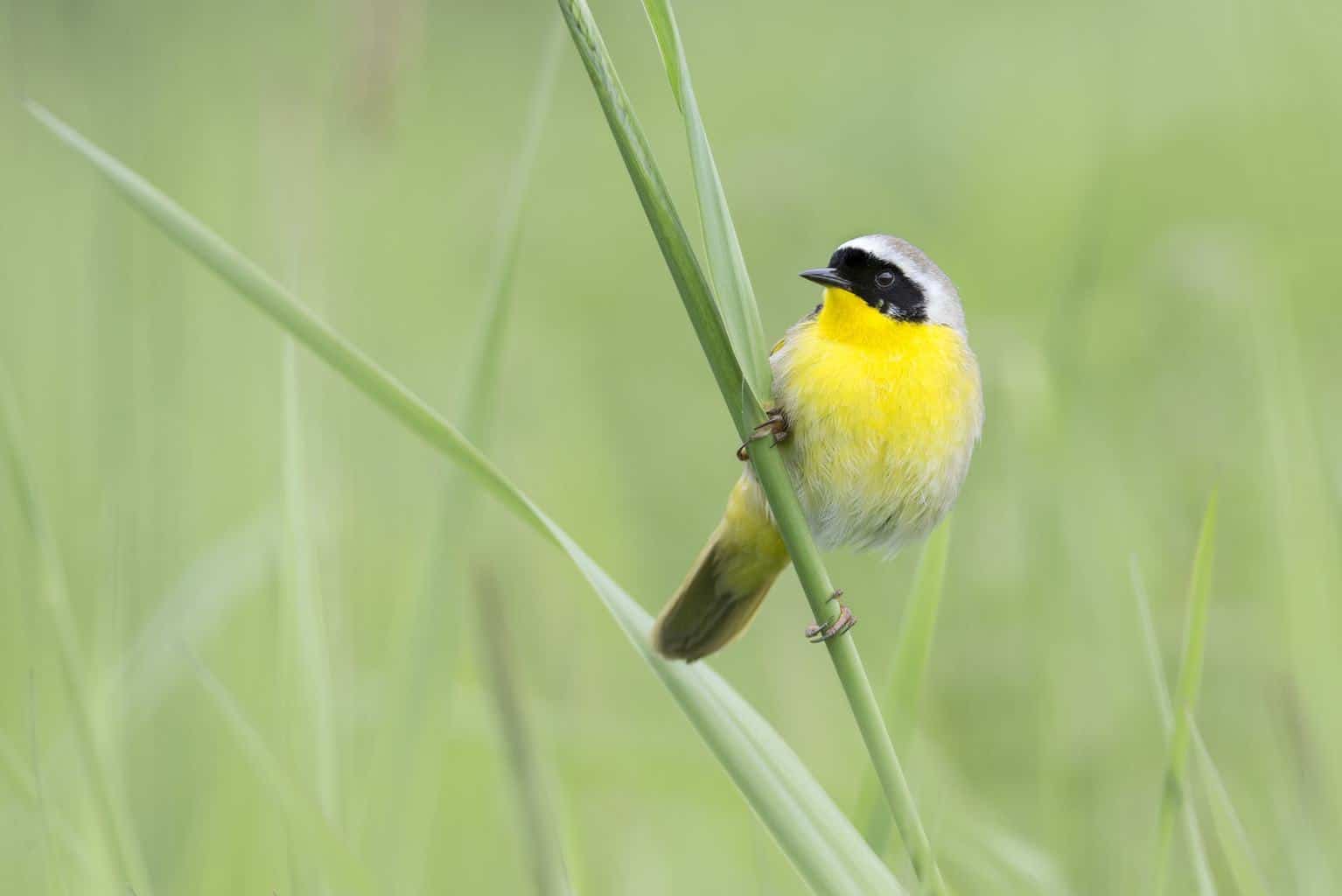
- Scientific Name: Geothlypis trichas
- Length: 4 – 5 in
- Weight: 0.3 – 0.5 oz
- Wingspan: 6 – 7.5 in
Common Yellowthroats are small, slow birds that are weak in flight. Still, they’re able to catch dragonflies, spiders, and even grasshoppers. They’re known to inhabit shrubbery and agricultural lands where they forage for seeds and berries. You can also spot them in marshes, damp grasslands, and willows near bodies of water.
Common Yellowthroats aren’t as common as the name suggests because they’re in Illinois only during the summer. They do have bright yellow throats, though. Adult males are bright yellow with a black face. Their upper parts have tinges of olive-yellow and fine, white lines. Females are olive-brown all over. Yet, they have tufts of bright yellow under their throats and tails.
Eastern Meadowlark
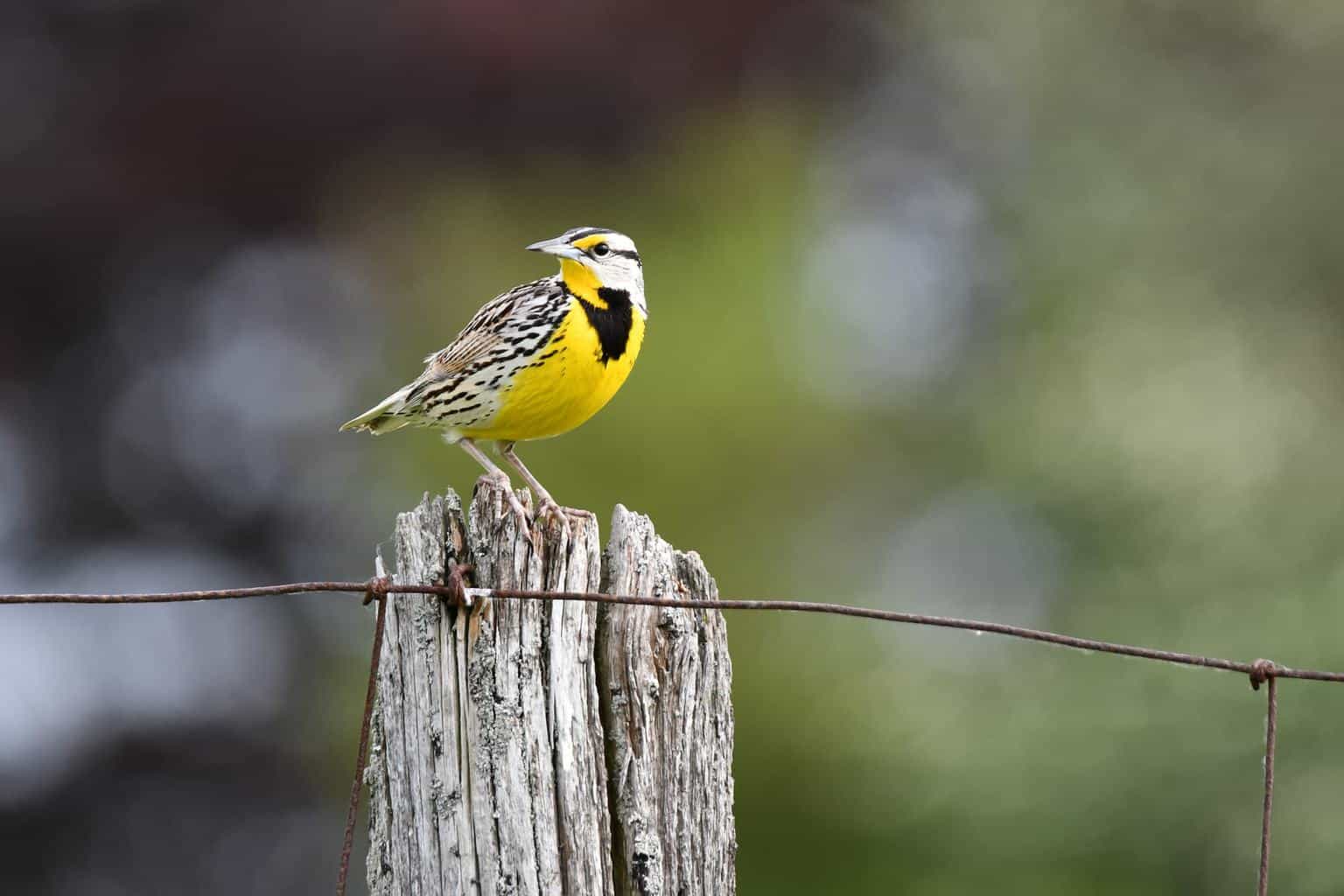
- Scientific Name: Sturnella magna
- Length: 7.5 – 11 in
- Weight: 3 – 5 oz
- Wingspan: 13.5 – 16 in
Eastern Meadowlarks prefer meadows, prairies, and grassy fields where they can forage for food at their leisure. But, despite their small size, they’re brazen enough to venture out onto open areas and country roadsides. You can find them perching on utility wires and fence posts.
Eastern Meadowlarks are marked by the bright yellow on their foreheads, chests, and throats. The rest of their bodies are covered in darker shades and striations. There’s a noticeable black “V” that runs across their bright yellow chests. This “V” turns gray in winter. Their tails are mostly brown, while their wings are pale with white edges.
Western Kingbird
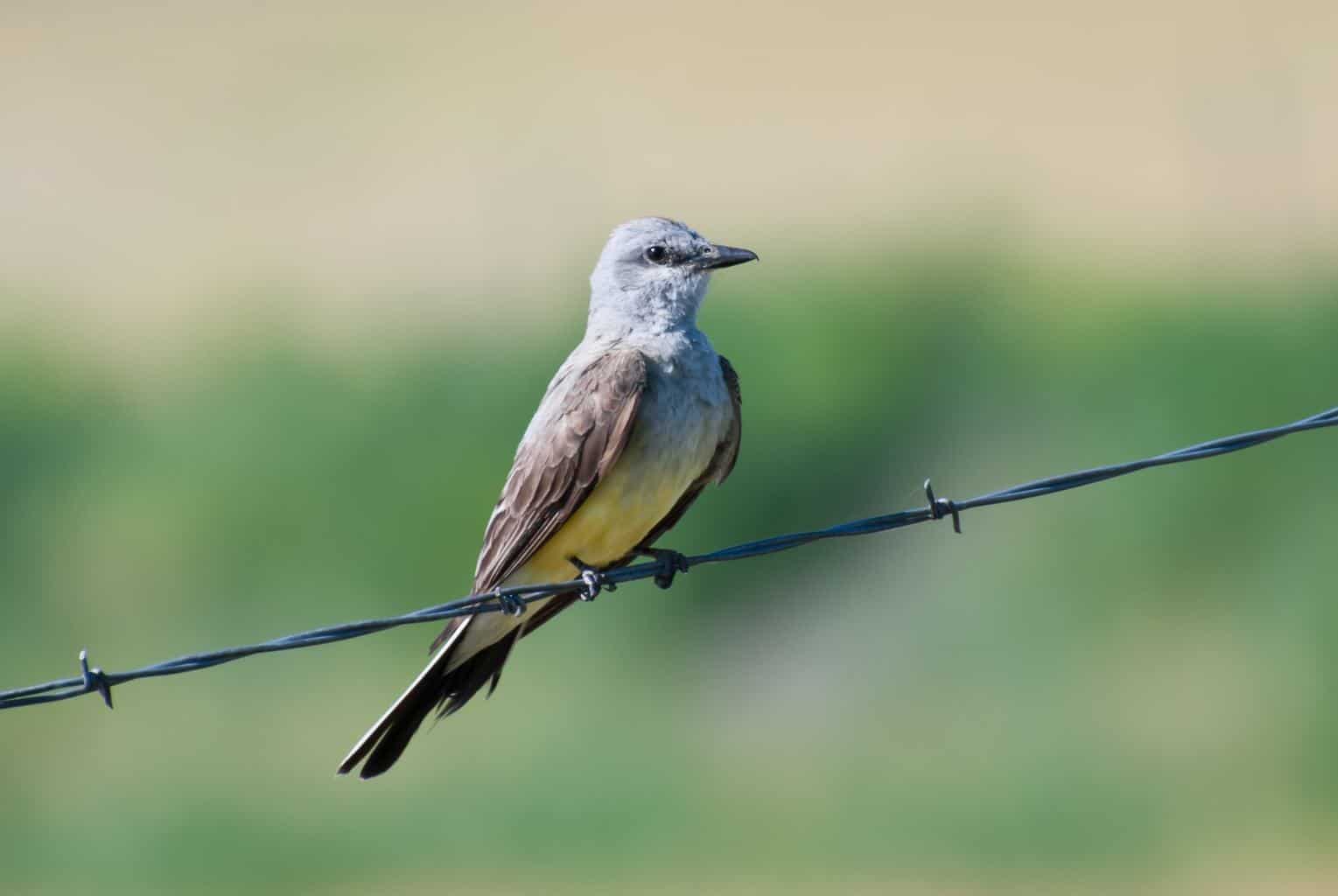
- Scientific Name: Tyrannus verticalis
- Length: 8.5 – 9 in
- Weight: 1 – 1.5 oz
- Wingspan: 15 – 16 in
Western Kingbirds are mainly seen in southern Illinois, near the Missouri border. They can be recognized by their fluttering movements, almost like a butterfly. These graceful birds can grab their prey in mid-air.
You can see them by streams and ponds with plenty of trees around. Ranches, meadows, and orchards are also some of their preferred habitats. It’s where they can find plenty of insects and seeds to munch on.
Western kingbirds have gray heads and white throats and chests. Their bellies are a bright shade of yellow. A distinguishing feature is their black tails with white outer edges. They’re especially striking during flight.
Yellow Warbler
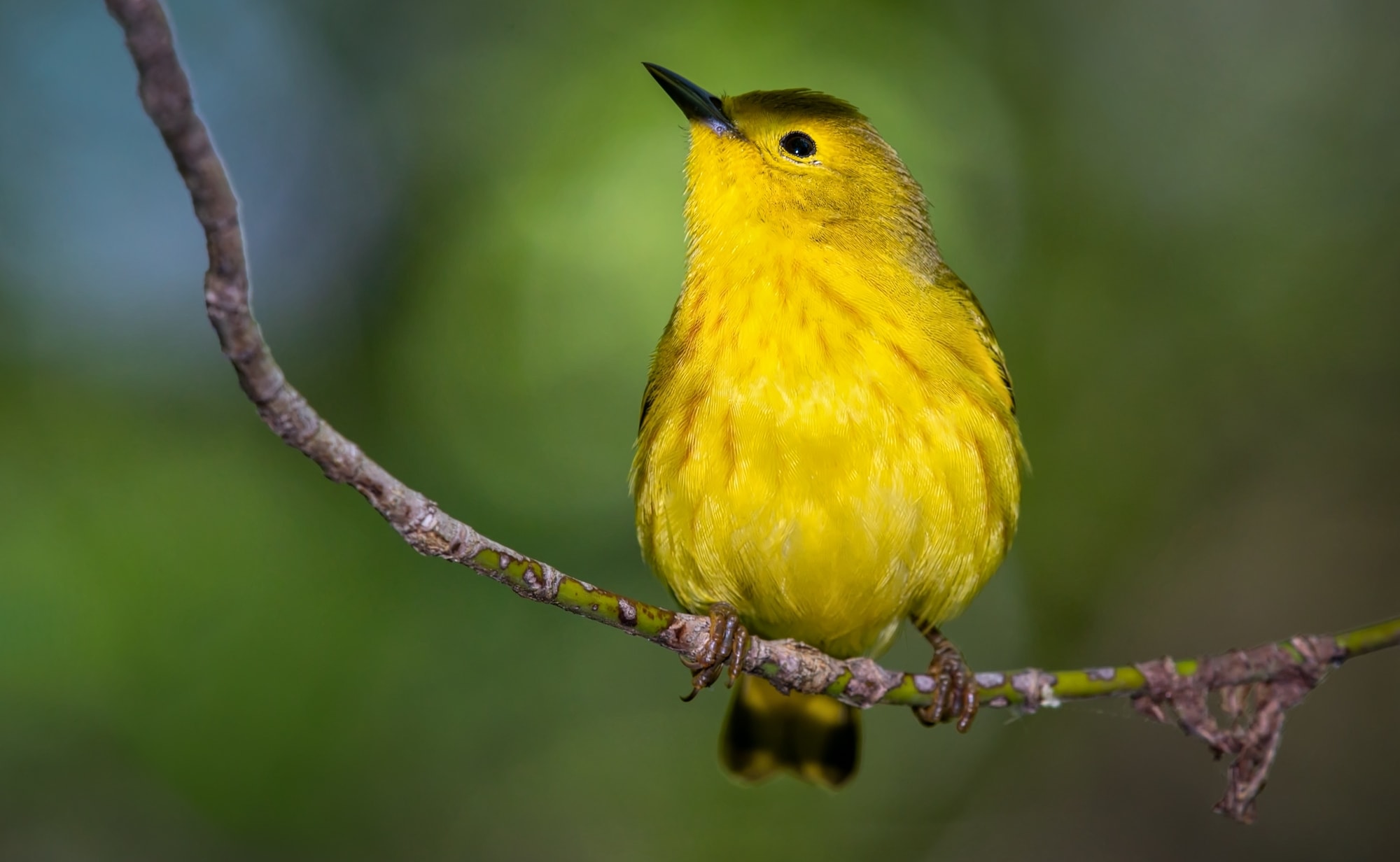
- Scientific Name: Setophaga petechia
- Length: 4.5 – 5.5 in
- Weight: 0.3 – 0.5 oz
- Wingspan: 6 – 8.5 in
The Yellow Warbler has the widest range of all other North American warblers. You can spot them in a wide range of habitats, including orchards, suburban gardens, and willow-lined streams. Their favorite meals include insects and spiders. They also feed on berries, fruits, and nuts.
These summer residents are covered in yellow plumage. Their wings and tails have faint, dark stripes. Both males and females have unmarked faces that draw your attention to their large black eyes.
Other Birds To Watch for in Illinois
Below are a few other birds we’ve come across in the Prairie State. Let’s take a look.
Black Birds in Illinois
American Crow
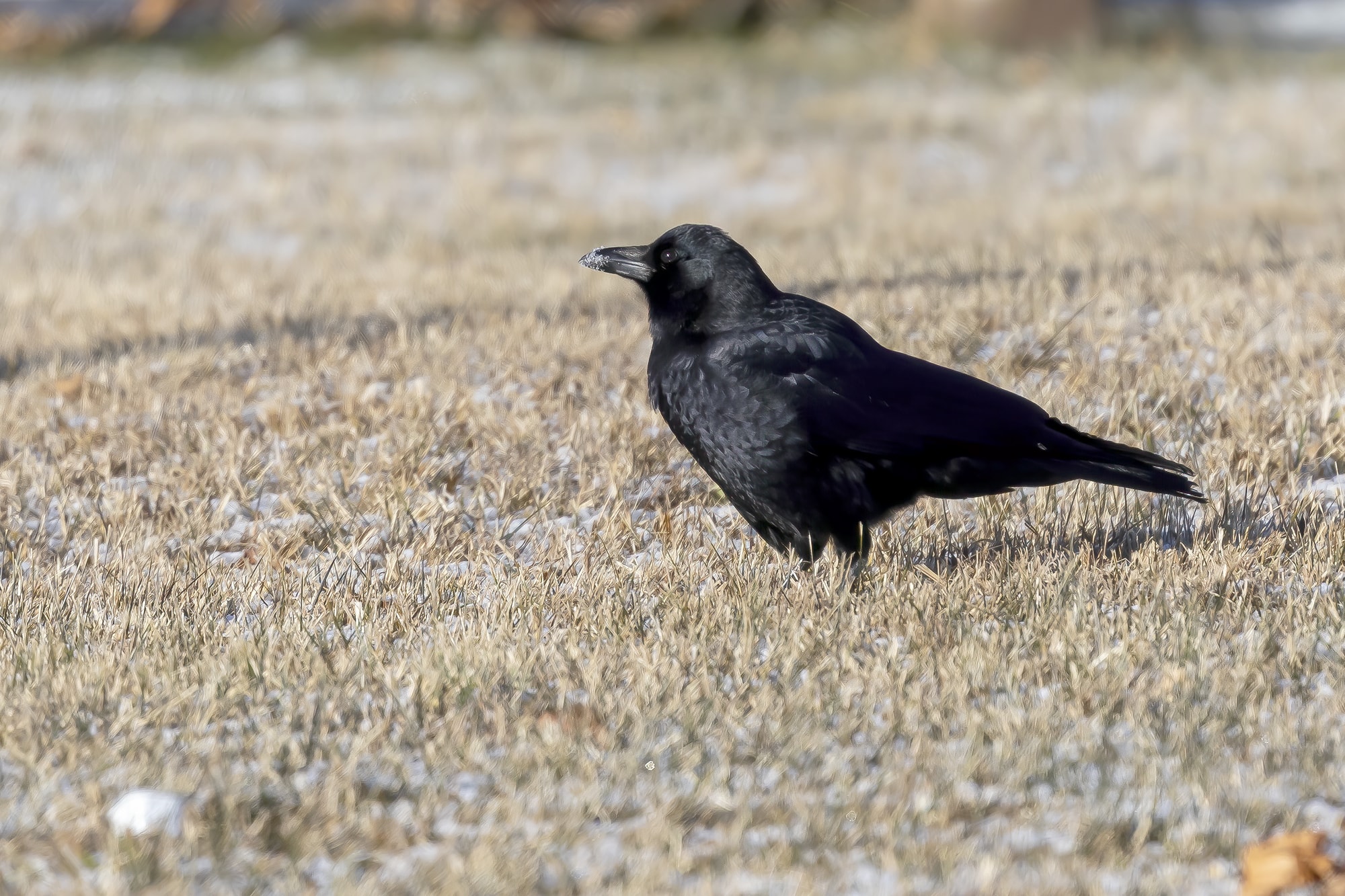
- Scientific Name: Corvus brachyrhynchos
- Length: 17 – 17.5 in
- Weight: 15 – 16 oz
- Wingspan: 33 – 40 in
American Crows are ferocious-looking birds known for their penetrating glare. They eat almost everything they come across, including the eggs and young of other birds. These social birds prefer to be around farmlands, open fields, and along shorelines. However, you can also see them perching on high utility lines and telephone poles.
Their head-to-tail all-black body gives them an ominous look. Even their bills and legs are covered in black.
Tufted Duck
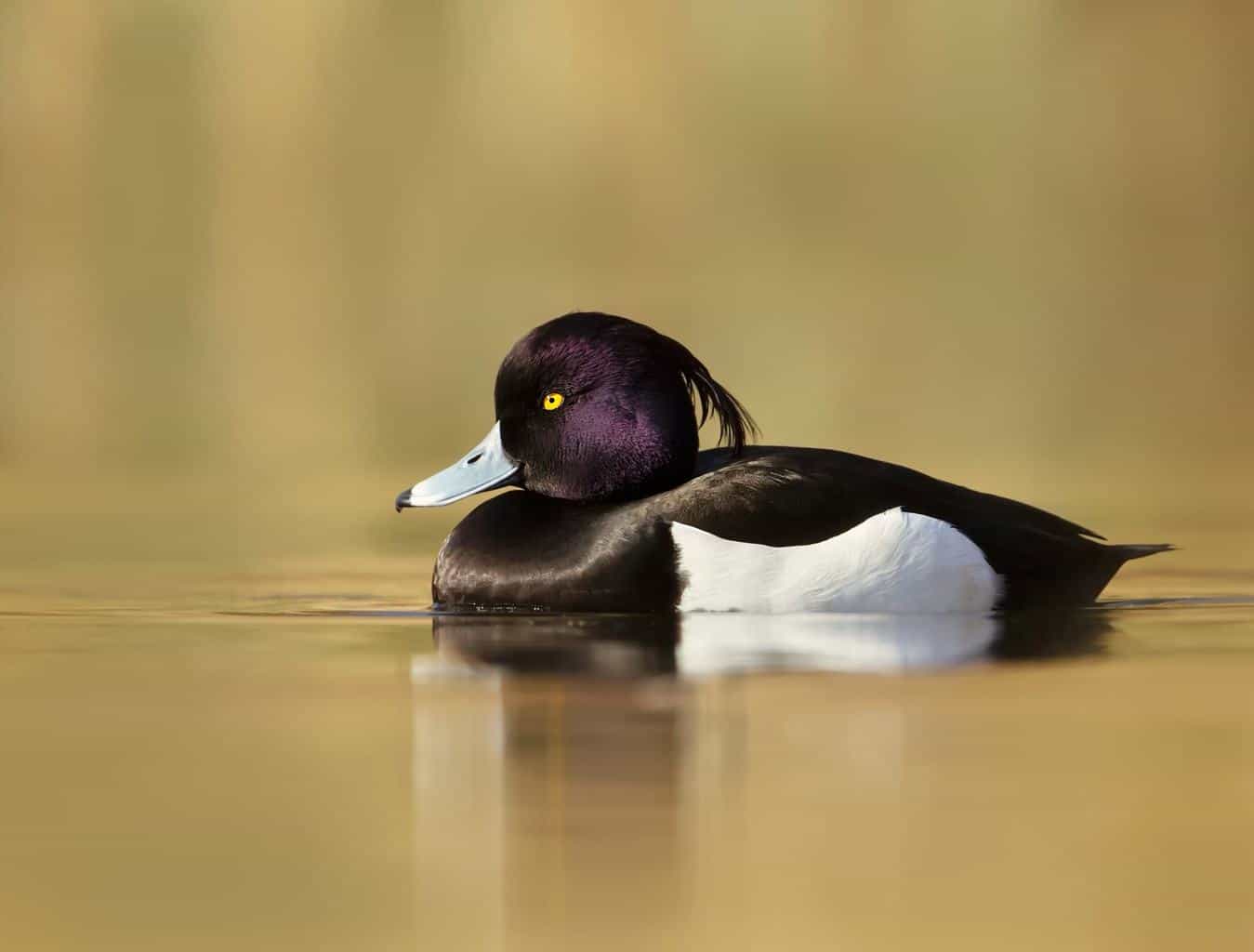
- Scientific Name: Aythya fuligula
- Length: 17 – 18 in
- Weight: 35 – 36 oz
- Wingspan: 22 – 26 in
Tufted Ducks are diving experts, going down to a depth of 10 feet. They feed on aquatic plants and insects, as well as small amphibians and fish. Luckily, these migratory birds have become accustomed to man-made lakes. It’s one of the reasons their range and numbers are on the rise.
The tufted duck has a black head, neck, and chest. It’s white on either side, which makes it easy to distinguish.
Brown Birds in Illinois
Broad-Winged Hawk

- Scientific Name: Buteo platypterus
- Length: 13 – 19 in
- Weight: 14 – 17 oz
- Wingspan: 32 – 39 in
Often spotted during the summer, Broad-winged Hawks are mighty-looking creatures. They prey on everything from birds and large insects to amphibians and small mammals. You can’t miss their wide wings as they soar through the air. They usually take advantage of updrafts and thermals to make their flight smoother and more continuous.
Broad-winged hawks are reddish-brown with barred underparts. Their tails have broad black and white stripes, which are more prominent in flight.
House Wren
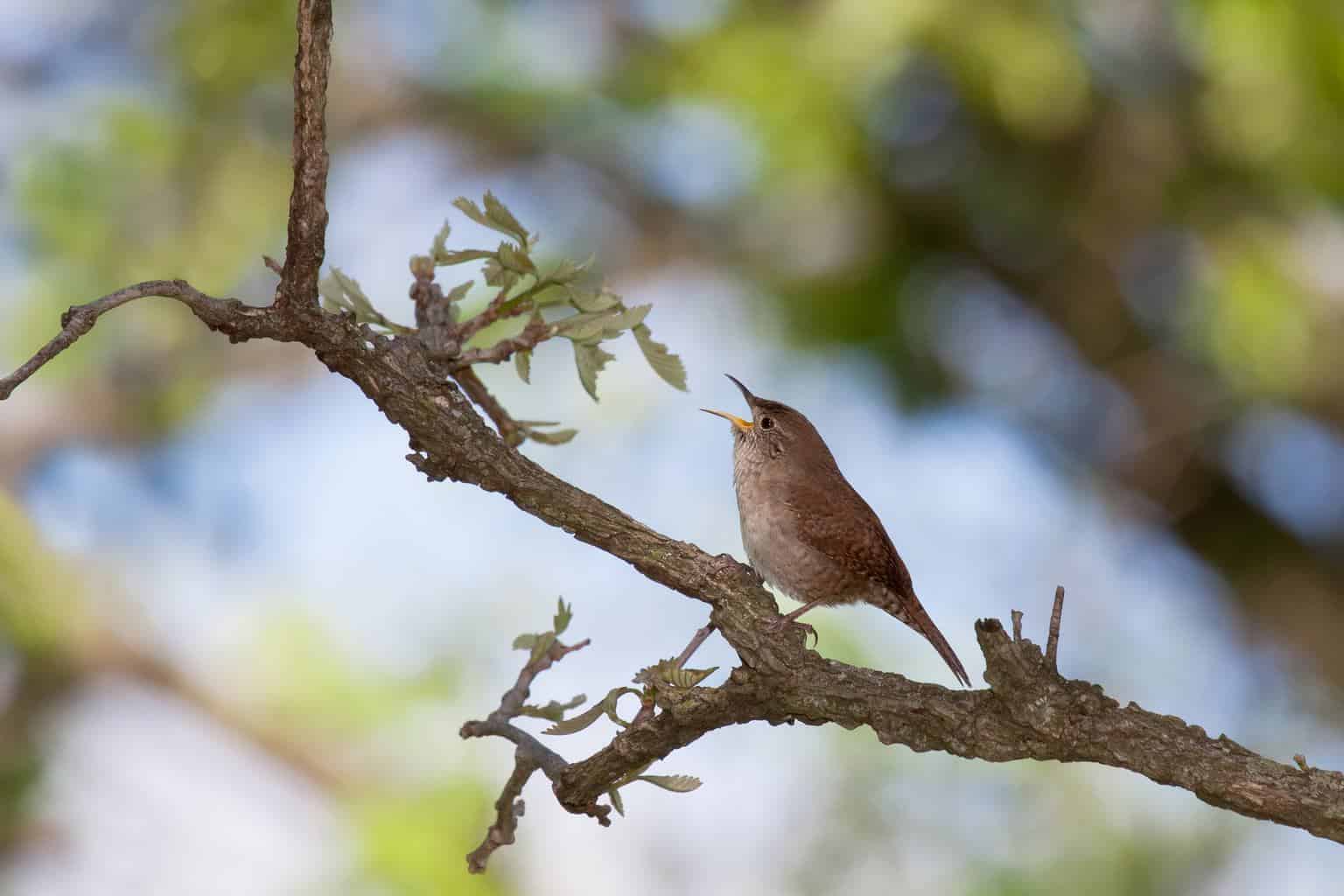
- Scientific Name: Troglodytes aedon
- Length: 4 – 5 in
- Weight: 0.4 – 1 oz
- Wingspan: 6 – 7 in
You can spot these small birds during the summer in forest openings and woodlands. They like to feed on insects, caterpillars, and spiders by gleaning them from leaves and twigs.
House Wrens are covered in various shades of brown. Their tails and wings are characterized by dark bands. These bands contrast their white throats, necks, and eyebrows.
Gray Birds in Illinois
Dark-Eyed Junco
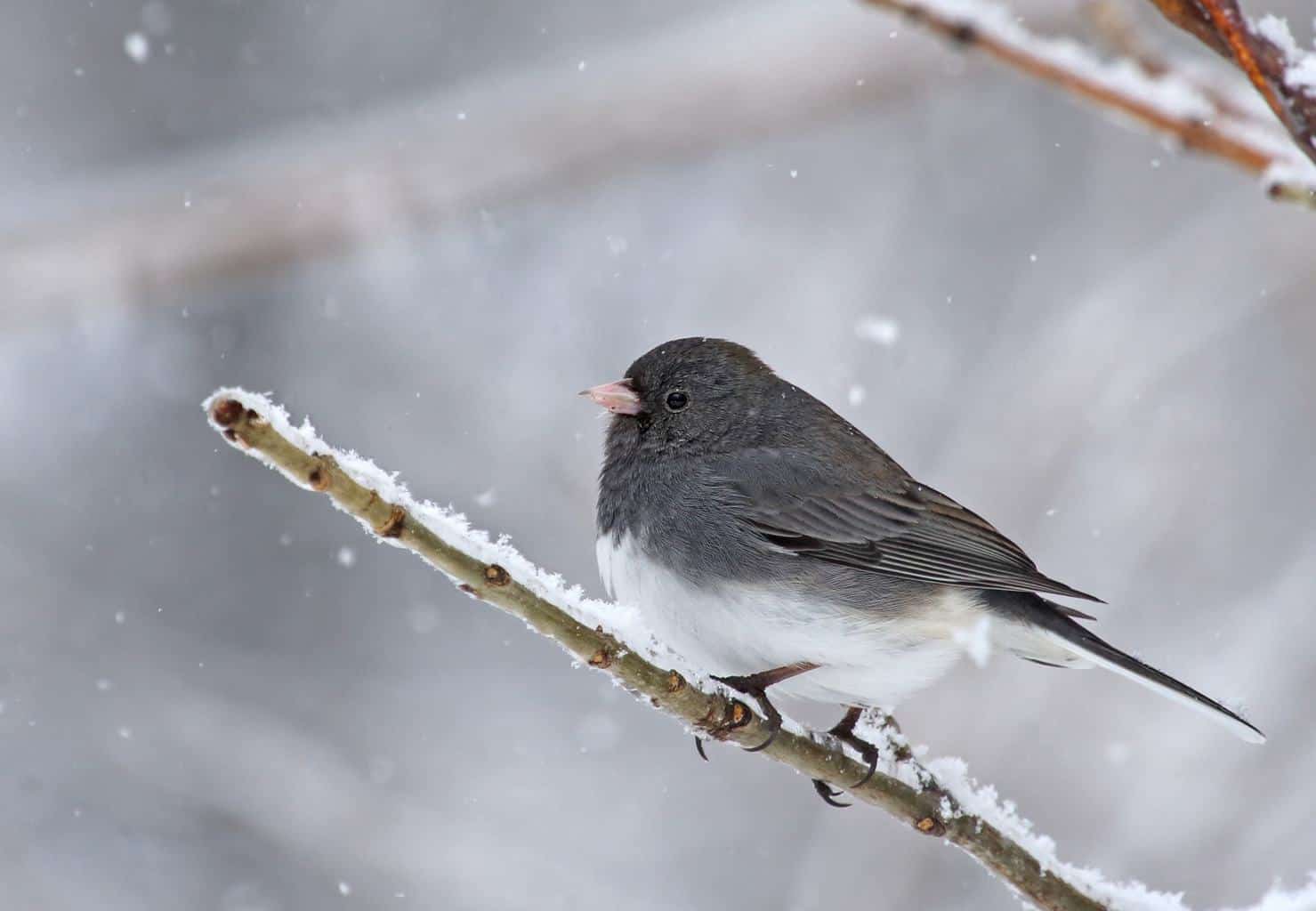
- Scientific Name: Junco hyemalis
- Length: 5 – 6.5 in
- Weight: 0.5 – 1 in
- Wingspan: 9 – 10 in
Unlike many other bird species, Dark-eyed Juncos are winter birds in Illinois. Their preferred habitat is coniferous forests, farmlands, and suburban gardens. They forage for food by clawing the ground. Their diet consists of insects, seeds, and berries.
Dark-eyed Juncos are gray with brown markings. Their dark coloration is brightened by their pink bills and pale gray outer tail feathers.
Mourning Dove

- Scientific Name: Zenaida macroura
- Length: 9 – 13 in
- Weight: 3.5 – 6 oz
- Wingspan: 15 – 18 in
Mourning Doves are graceful birds found in parks, lawns, and open fields. As long as there are trees and plenty of food, these doves will be around. These common backyard birds forage on the ground for seeds, fruits, and insects. They drink through a suction process, so they don’t need to raise their heads to swallow. You can also attract them to your bird feeding station quite easily.
Mourning doves are covered in pale shades of gray. Their wings and tails have black spots and white tips.
White Birds in Illinois
American White Pelican
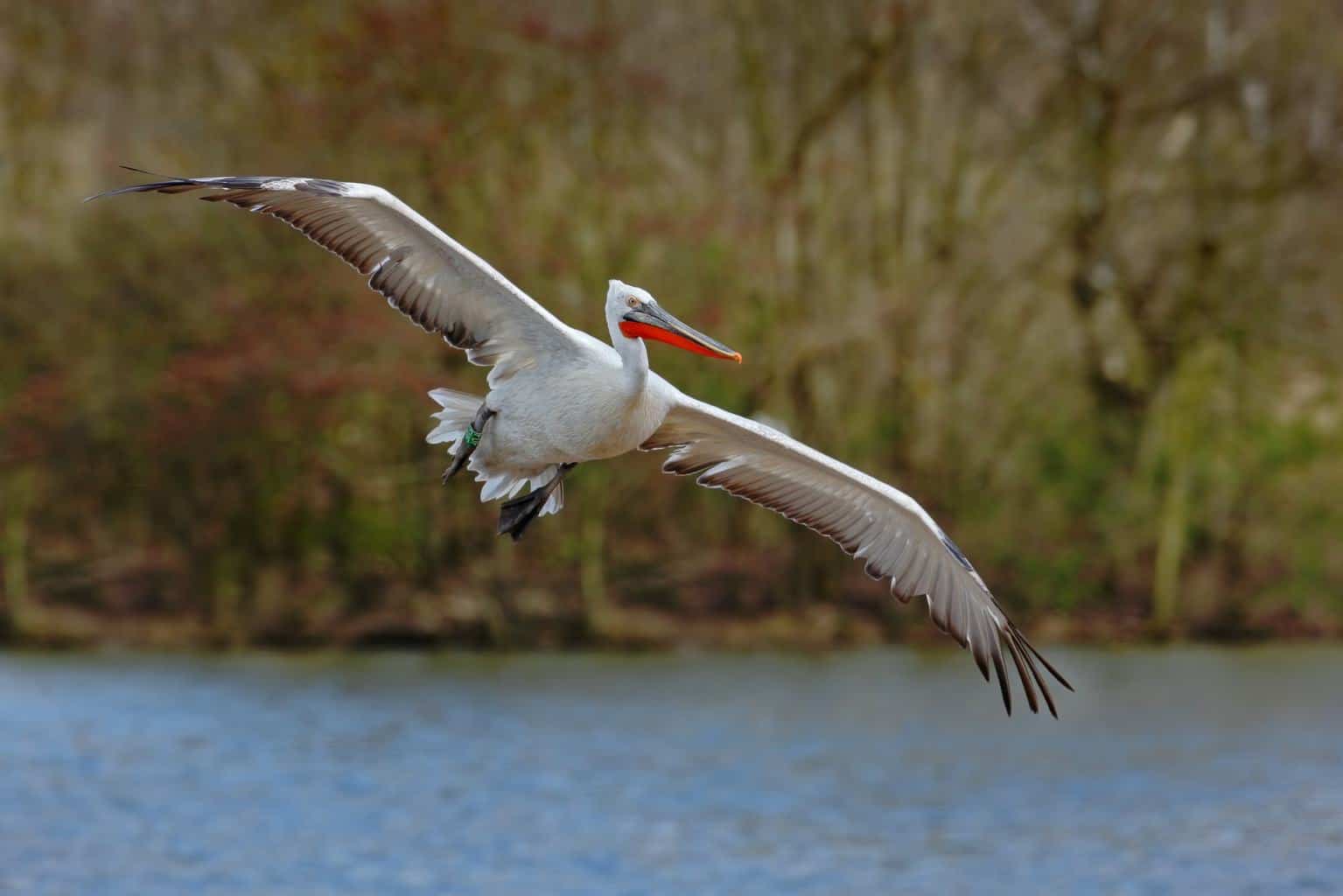
- Scientific Name: Pelecanus erythrorhynchos
- Length: 50 – 65 in
- Weight: 160 – 300 oz
- Wingspan: 96 – 110 in
American White Pelicans are one of the largest boreal birds. Their bills act as a sieve, allowing the water to drain out while keeping the fish they catch safely inside. Sadly, their numbers are in decline due to the draining of wetlands and human disturbance. The good news is that they’re protected by the Migratory Bird Treaty Act of 1918.
While they appear snowy white, these pelicans have black primary feathers that only appear when they spread their wings. In addition, their bills and legs are dark yellow, and they have tufts on their chests that turn yellow in spring.
Barn Owl
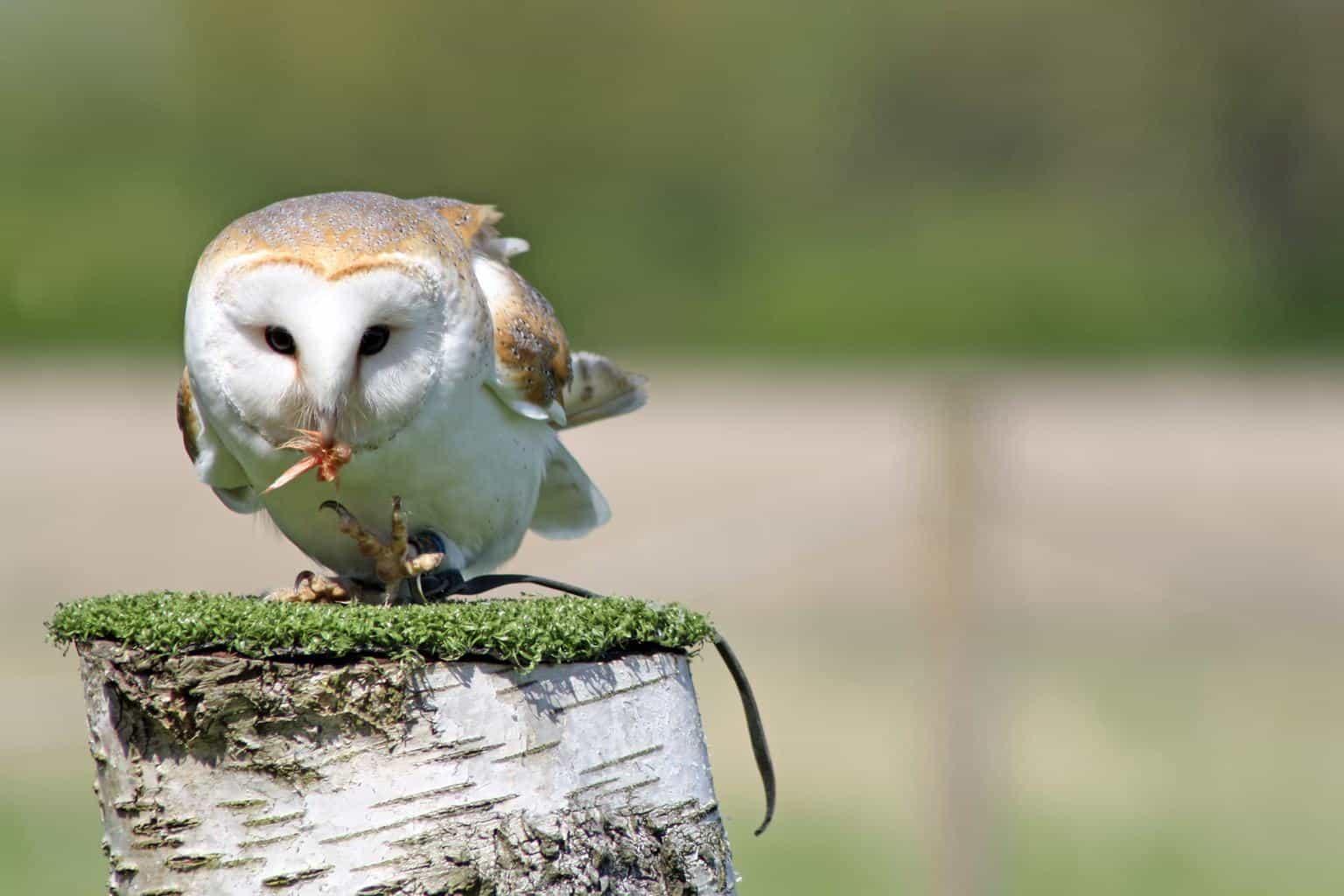
- Scientific Name: Tyto alba
- Length: 13 – 20 in
- Weight: 14 – 25 oz
- Wingspan: 41 – 47 in
Bird watchers can find barn Owls in a wide range of habitats. Yet, they mostly prefer open grasslands in southern Illinois.
Their best feature is their exceptional hearing, thanks to their asymmetrical ears and the shape of their facial discs. As a result, they can easily sense prey hidden deep in the snow or vegetation.
Barn owls are known for the snowy white plumage on their chest. Yet, it changes with the light from pale tan to light gray.
Iridescent-Colored Birds in Illinois
Common Grackle
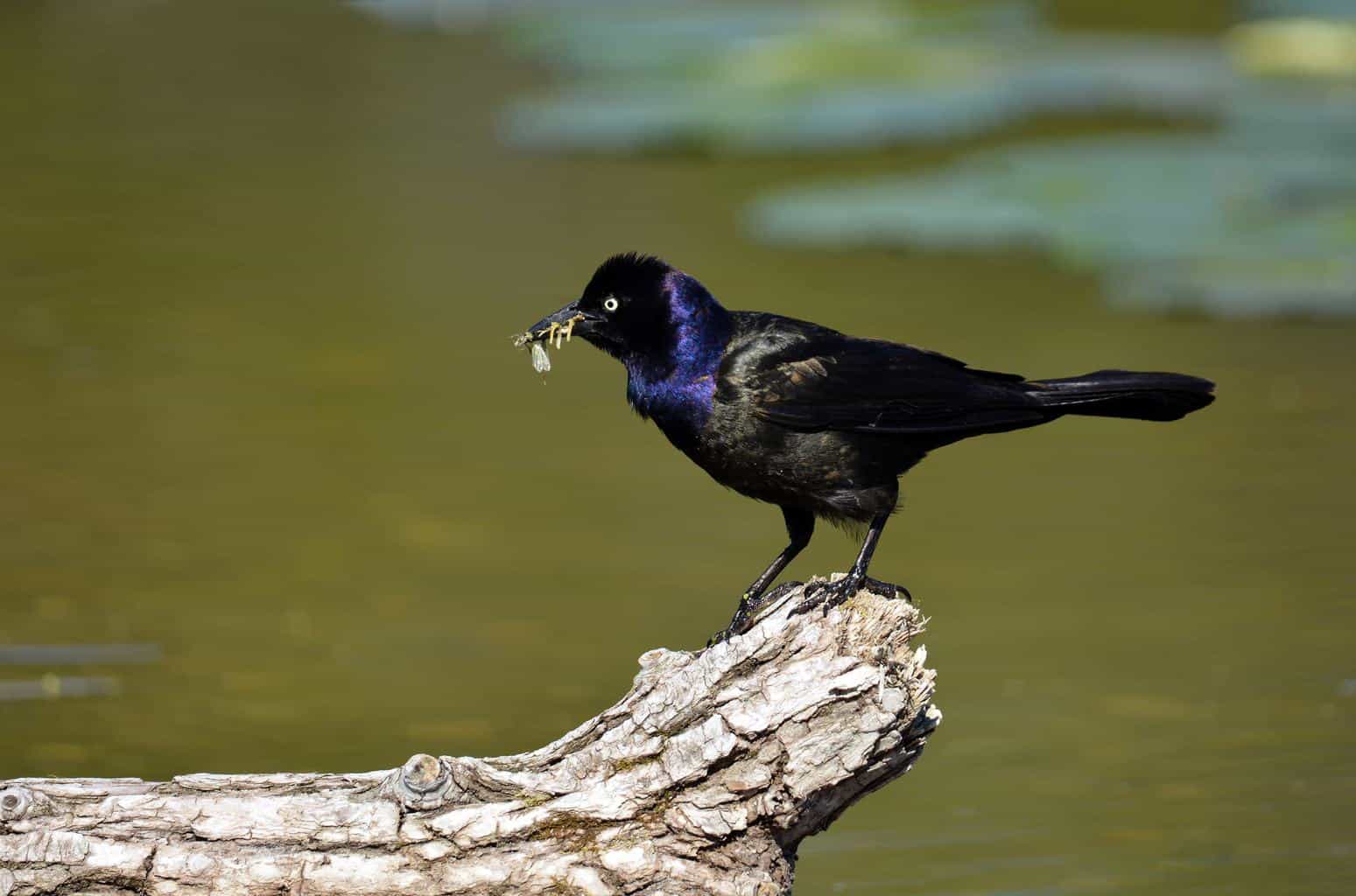
- Scientific Name: Quiscalus quiscula
- Length: 11 – 13.5 in
- Weight: 4 – 5 oz
- Wingspan: 17 – 18.5 in
You can find Common Grackles walking in meadows or open fields rather than hopping like other birds. They also inhabit shorelines where they can wade into the water to catch live fish. Unfortunately, they’re aggressive birds that will chase away other birds from backyard feeders.
These vibrant birds are covered in shiny, metallic purple plumage that shimmers in the sunlight. In contrast to their dark bodies, their eyes are bright yellow. Yet, in the distance, they often appear to be black. Females are typically less glossy than males.
European Starling

- Scientific Name: Sturnus vulgaris
- Length: 8 – 9 in
- Weight: 2.5 – 3 oz
- Wingspan: 15 – 16 in
European Starlings prefer being around ranches and farmlands where food is abundant. Yet, you can also spot them in cities and urban areas.
They have iridescent purple heads and shimmery green chests. Even their legs are striking with their bright shade of pink. In the winter, their plumage turns a brown shade. It’s often speckled with white spots.
Conclusion
There’s such an amazing variety of all kinds of birds in Illinois. You can watch these majestic creatures year-round, soaring overhead, perching on fences, or relaxing in the water.
If you want to attract them, fill your bird feeders with black oil sunflower seeds and safflower seeds. some of these birds will even eat leftover food
So, the next time you’re in the Prairie State, make sure you keep an eye out for any of the bird species we mentioned above. Happy birding!

